Affiliate disclosure: This post may contain affiliate links. Please see our Privacy Policy.
Orange flowering plants are a fan favorite with pollinators and foragers alike. While most are edible, many are not, but are useful in other ways! Keep your eyes peeled on the ground, but be prepared to look up for some of the vining plants.
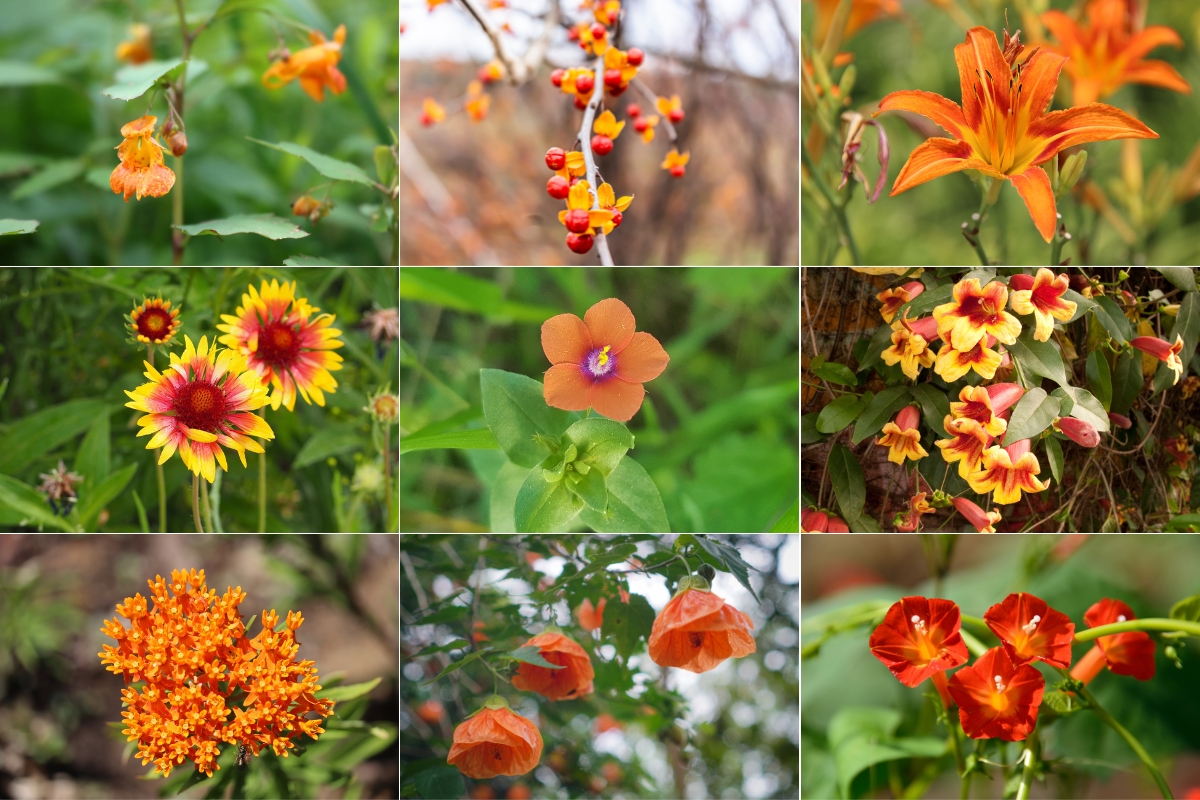
Table of Contents
- Weeds With Orange Flowers
- Blanket Flowers (Gaillardia sp.)
- Butterfly Weed (Asclepias tuberosa)
- Calendula (Calendula officinalis)
- Chinese Lantern (Abutilon pictum)
- Crossvine (Bignonia capreolata)
- Jewelweed (Impatiens capensis)
- Morning Glory (Ipomoea coccinea)
- Orange Daylily (Hemerocallis fulva)
- Orange Evening Primrose (Oenothera versicolor)
- Orange Hawkweed (Hieracium aurantiacum)
- Orange Nasturtium (Tropaeolum sp.)
- Oriental Bittersweet Vine (Celastrus orbiculatus)
- Red Sorrel (Rumex acetosella)
- Scarlet Pimpernel (Anagallis arvensis)
- Trumpet Vine (Campsis radicans)
- Wild Weeds
- Edible Wild Weeds
This article is written by Morgan Hyde, a reference librarian from Arizona. Her work for the library has refined her passion for learning and deep research—a passion that began in her rural AZ upbringing. If it’s something she can do on her own, it’s something she wants to know about!
Orange flowering plants exist in an interesting in-between: some of them are variants of yellow flowers and some of red, but few are most commonly orange. Likely, this is because red is a tricky color for bees to spot, and these plants are adding some yellow hue to draw them in.
Whatever the reason, orange flowers are beautiful and can be found on a variety of plant types. Interested in a bushy plant? You got it. Vines? You got it! Generally, they prefer sunny patches of soil and tend to be highly competitive– several of these plants are considered invasive, even the native varieties.
Many of these plants have medicinal qualities or are great as a tasty snack. Whether they’re native to the Americas or transplanted from across an ocean, traditional uses for these plants abound.
None of the plants in this list are considered poisonous, but many have toxic parts to them. Always be 100% certain of your identification with any wild plant, and consult multiple sources. Even once you ID something, consume in low quantities and with caution!
Weeds With Orange Flowers
These are the most common weeds that produce orange flowers. You’ll typically find them growing around your knees while you walk through sunny areas with disturbed soil.
The vines on this list all have the potential to climb, so be prepared to look up into trees or along light poles for them.
Plenty of these plants are invasive but are generally easy to manage. About half of the list began in North America as transplants, and some of them are harmless to their new environment. Just because you see a splash of bright orange in your garden doesn’t mean you have to remove it!
Blanket Flowers (Gaillardia sp.)
Given their own way, Blanket Flowers will live up to their name and create a dense carpet of color in the spring. Each plant loves to flower and can support up to 75 blooms at a time!
While not invasive, they do self-seed and will spread rapidly if left unchecked.
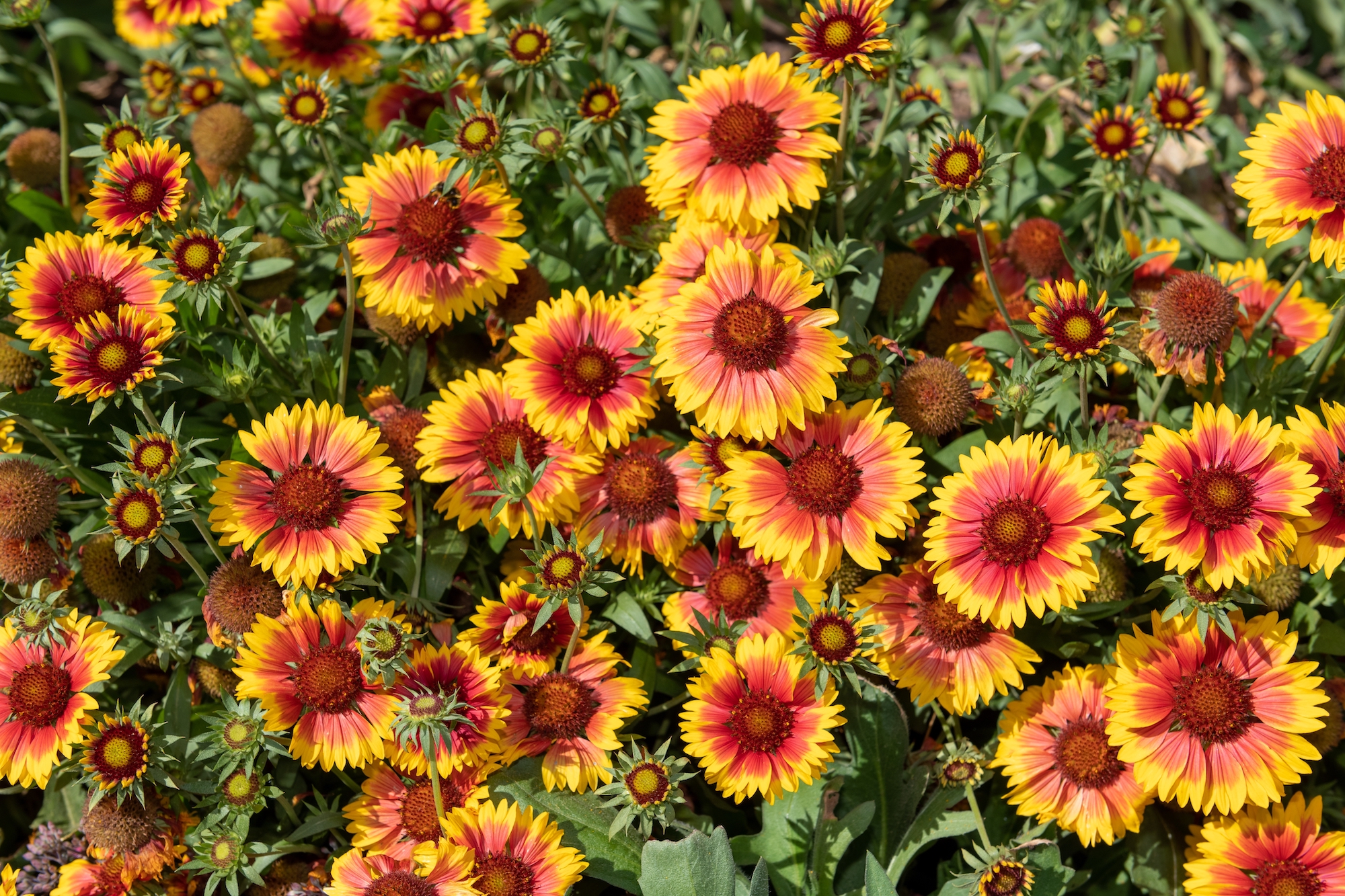
You’ll find Blanket Flowers in areas with well-draining soil and bountiful sunshine. I’d recommend wearing gloves and long sleeves while collecting any blooms—the sap can irritate skin on contact.
Considered a non-toxic plant, it isn’t a palatable one (though the honey from it has a wonderful buttery taste). Traditionally, an infusion of Blanket Flower leaves has been used as a diuretic or emetic.
The seeds can be dried, powdered, and used to create a seed butter spread. Make sure to use fully ripened seeds: the seed tufts should be completely white, and dark circles should show on the seed head.
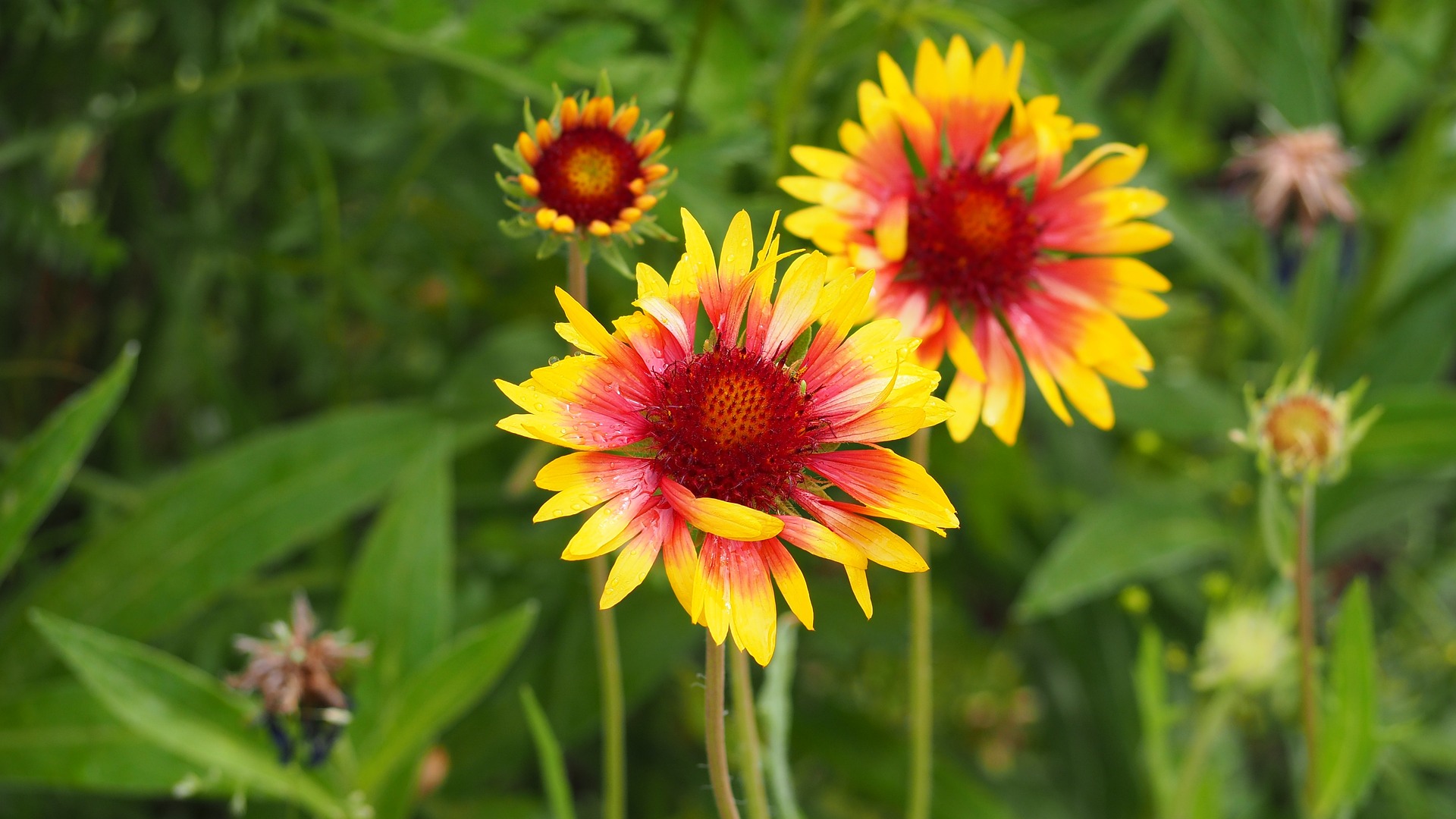
Key identifying features
Flowers:
- Daisy-like shape
- Darker orange at the center
- Light yellow petal tips
- Two “V” notches on each petal tip
- Grow on a long upright stem above the foliage
Seeds:
- Round dark seed head
Leaves:
- Fuzzy, light green
- “Strap” shaped
- Form at the base
Here is how to identify Blanket Flowers (Gaillardia sp.)
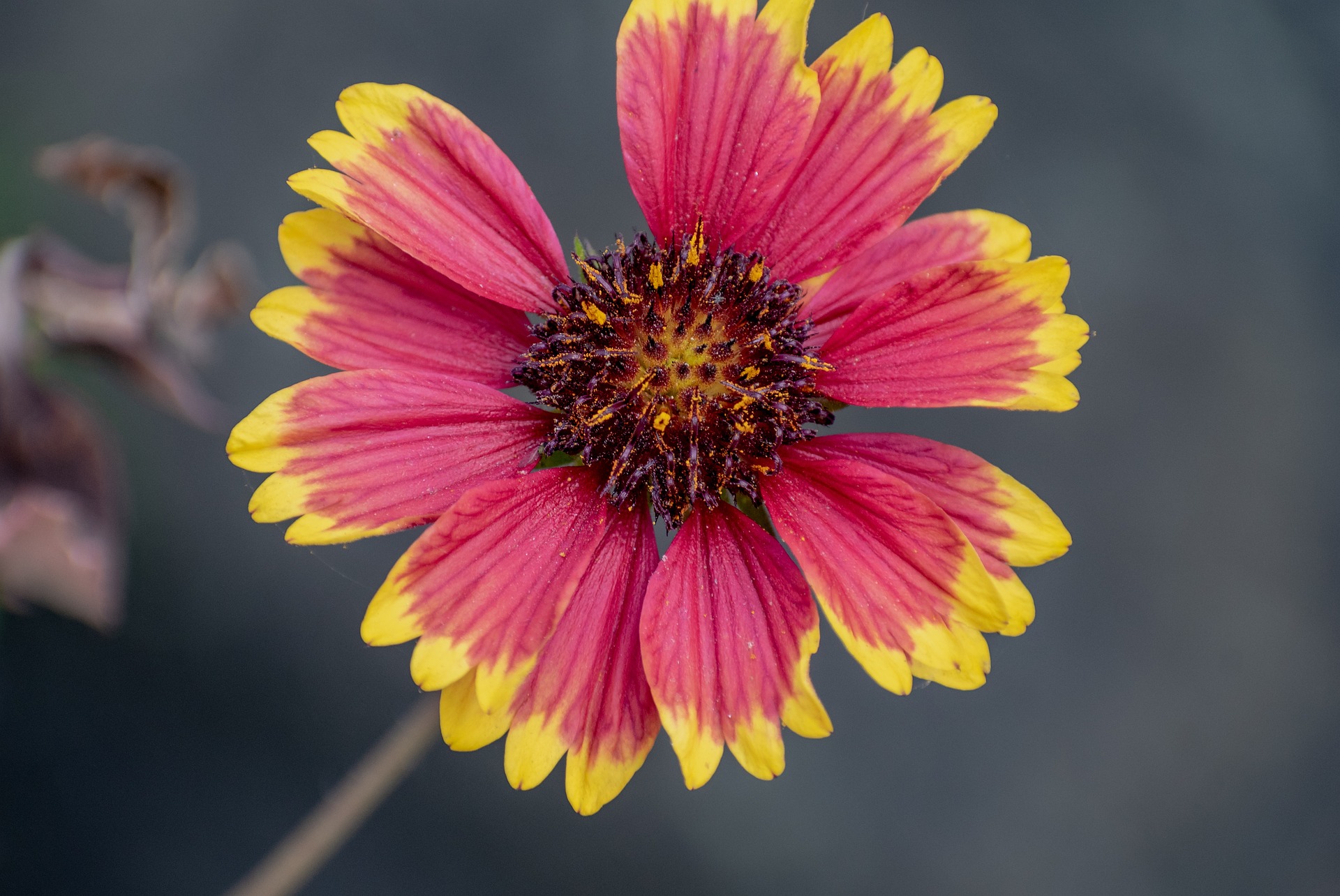
Butterfly Weed (Asclepias tuberosa)
A tall, bright, showy plant, it’s no wonder butterfly weed is known to attract large numbers of pollinators. As it often grows in prairies among less colorful neighbors, it’s easy to spot. Flower clusters decorate the tops of the individual plant stems in late spring, often with 25 tiny flowers all jumbled together. An excellent self-seeding plant, butterfly weed can become invasive by taking over empty soil; the taproots are woody, long, and difficult to remove fully.
Preferring open areas with little shade, butterfly weed can grow in most soils if given enough drainage. Butterfly weed is a member of the milkweed family but doesn’t have the thick opaque sap that genus is known for. Instead, the sap tends to be watery and translucent. Milkweeds are known to be toxic to people and animals, primarily due to cardiac glycosides found in the sap. On the whole, butterfly weed is thought to have a lower concentration of these chemicals, and so is likely less toxic.
Historically, butterfly weed has been considered a medicinal plant as the roots and leaves were used to treat asthma and bronchitis. But any part of the plant can become an emetic in high doses.
You can make a rough cloth or tough cords from the fibers found in the stems of butterfly weed. Once the plant begins to die back in the winter, break open the stems to release the fibers. Drawing these over a hard surface will help break them down into threads that can then be used in your textile projects.
Key identifying features
Butterfly weed is commonly confused with Garden Phlox when neither plant is flowering. When examining the leaves check for length: Garden Phlox has much shorter leaves.
Flowers:
- Grows in umbrella-like clusters 2-5in across
- Each cluster has up to 25 tiny flowers
- Flowers have 5 petals and a 5-part crown
Seeds:
- Seed pods are 3-6 inches long
- Grayish green, spindle-shaped seed pods
Leaves:
- Simple and long
- Glossy topped with fuzzy undersides
General:
- Bushy and dark green with multiple erect stems
- Hairy stems that are green or reddish purple
- Sap is clear
- Dies back to stems in winter
Here is how to identify Butterfly Weed (Asclepias tuberosa)
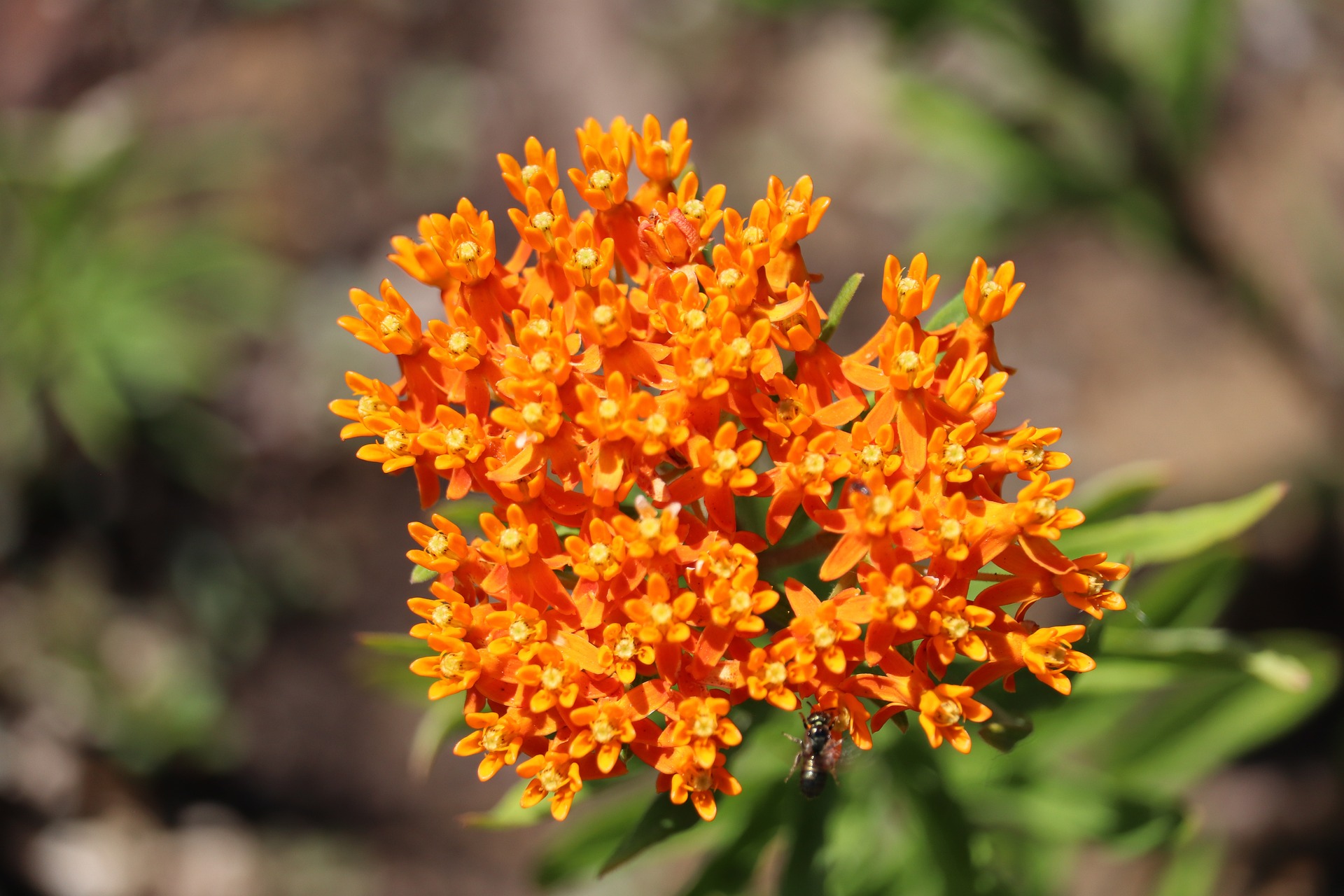
Calendula (Calendula officinalis)
An Old-World classic since the time of Shakespeare and considered a medicinal plant since at least the 12th century, there’s a lot of generational love for Calendula. You can find it growing in sunny areas in spring and wilting in those same areas in summer. Calendula has a short flowering window from May to June but occasionally will bloom again in the fall after a clement July and August.
A bushy plant, you’ll find both the plentiful leaves and vibrant flowers are edible. Like dandelion greens, Calendula leaves are bitter and best used as a garnish or mixed into a salad. The flowers, on the other hand, have a peppery taste and add wonderful color to any dish they join. Use them fresh, or dry them to make them into teas or seasonings!
Salves made out Calendula petals can hydrate dry and irritated skin. Eating the flowers (or drinking them in a tea) can provide a wide range of health benefits from reducing inflammation to acting as a mild laxative. And if that weren’t enough uses for these flowers, you can even apply the petals as a yellow dye for fabrics.
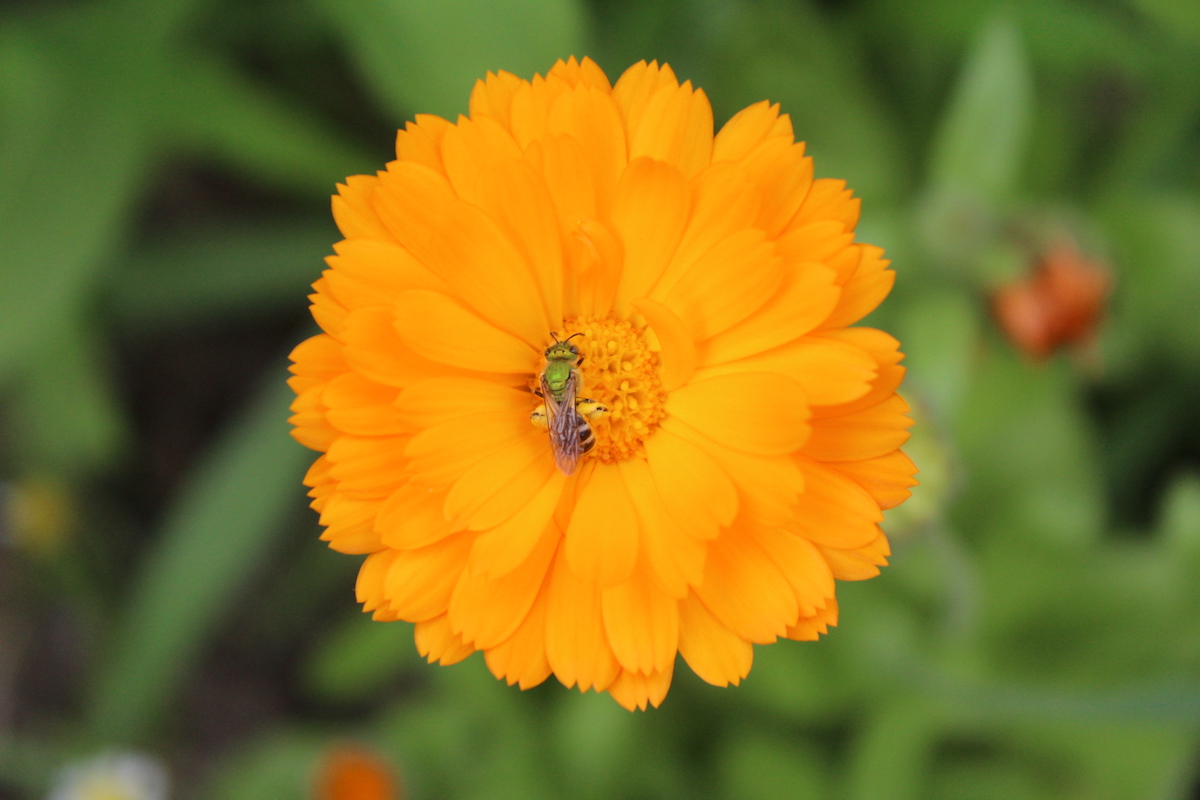
Key identifying features
The common name “pot marigold” may cause you to think Calendula is a part of the marigold family, but the two are actually very distinct plants and are easily distinguished. Only the names get confused!
Flowers:
- Daisy-like
- 2-3in across
- An outer and an inner row of petals
- Pollinated flowers curl in on themselves
Seeds:
- Form a brown corona when dry
General:
- Bushy in shape
- Wavy-shaped, fragrant leaves
- Fuzzy, tall stems
Here is how to identify Calendula (Calendula officinalis)
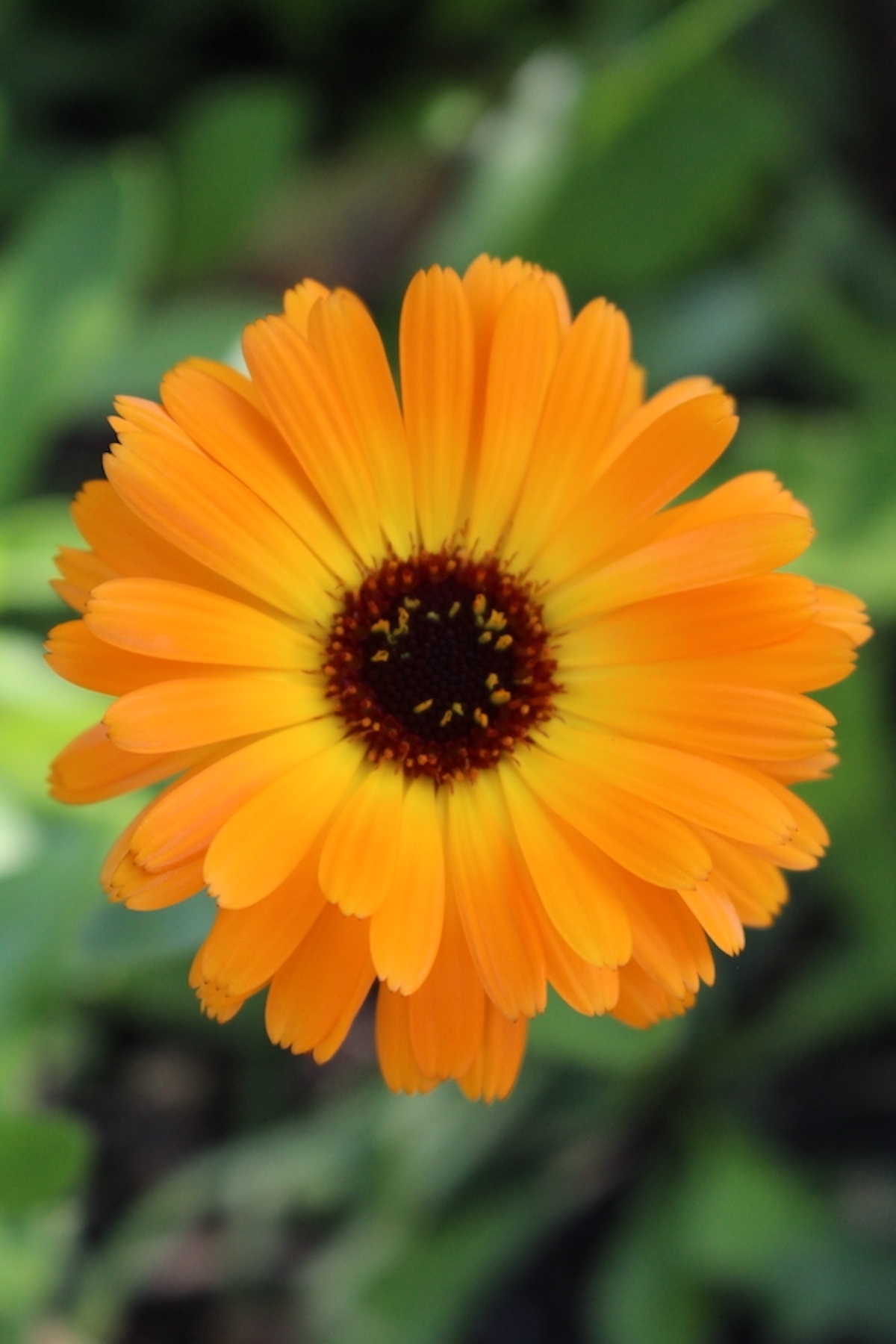
Chinese Lantern (Abutilon pictum)
You might need to look up to find this plant as it regularly grows up to 10 feet tall! Chinese Lantern—also known as Flowering Maple—is classified as a shrub but can be trained as a tree or even a vine.
During the summer and fall, you can find orange flowers dipping down from the ends of the Chinese Lantern’s branches.
As buds, they look like little bulbs, and as open flowers, they form delicate cups.
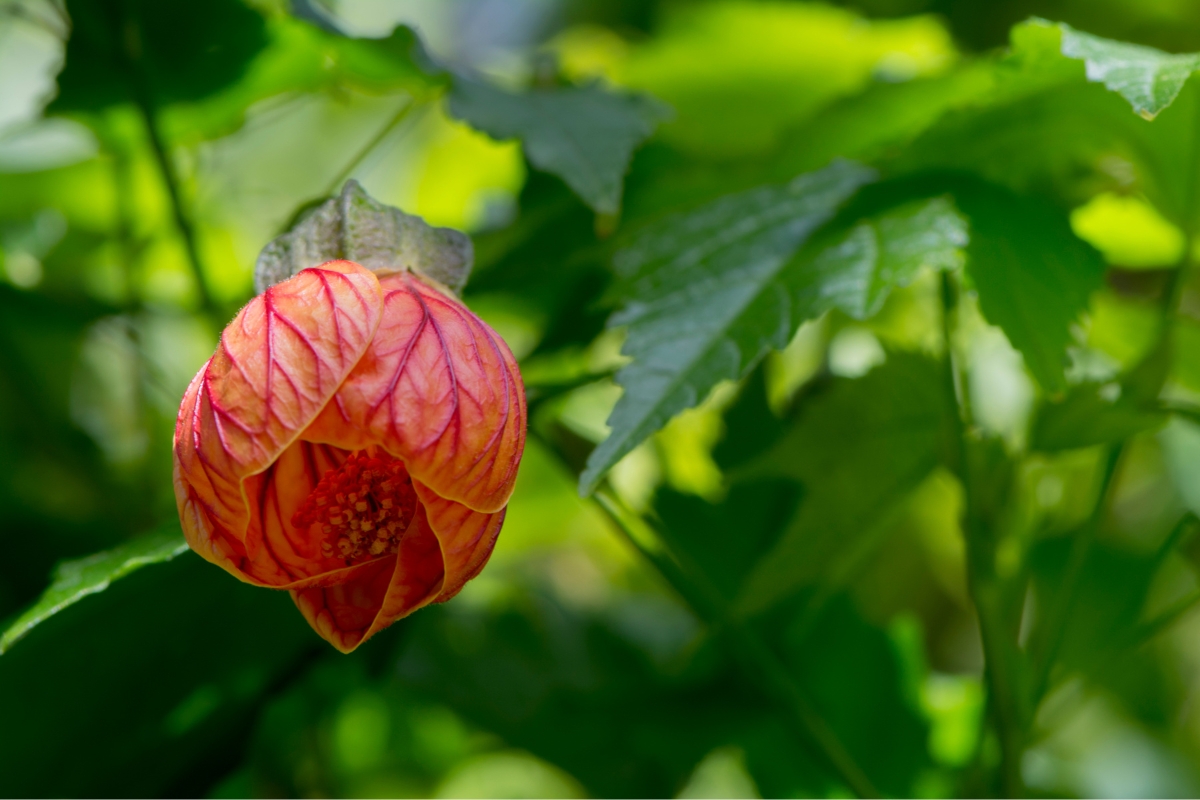
The flowers steal the show with this plant—beside looking beautiful, they’re edible and have a sweet taste.
They’ll taste sweeter the longer they’ve been open, so leave those buds alone!
Once you’re ready to harvest, put on some gloves (the leaves can cause skin irritation) and pluck the flowers for tea or as a treat for turtles.
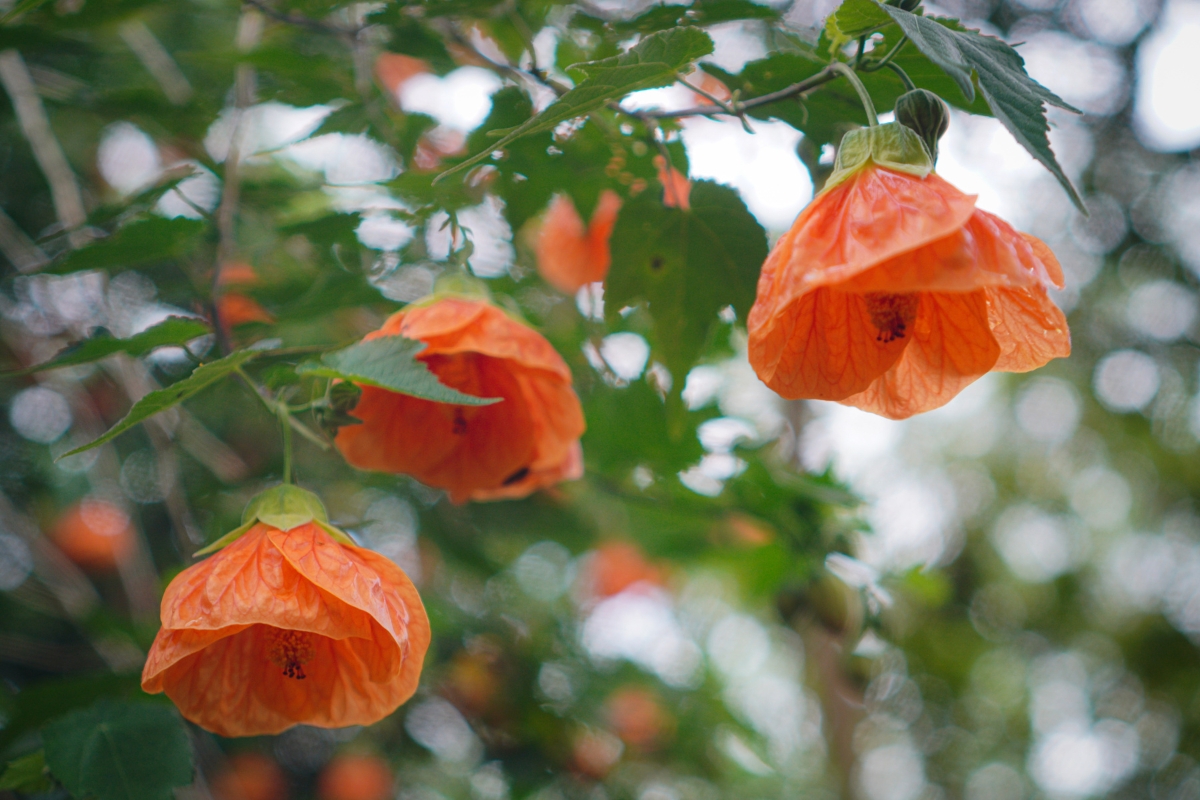
Key identifying features
Flowers:
- Solitary
- Grow on branch ends
- 5 petals
- Dark red veins
- Buds are lantern shaped
- Open flowers are 3in wide
- Cup-shaped and downward facing
Seeds:
- Pods are domed
- Pods are segmented (shaped like a barrel cactus)
Leaves:
- Maple leaf shape
- 3-5 lobes
- Dark green
- 3-5 leaves per branch
Here is how to identify Chinese Lantern (Abutilon pictum)
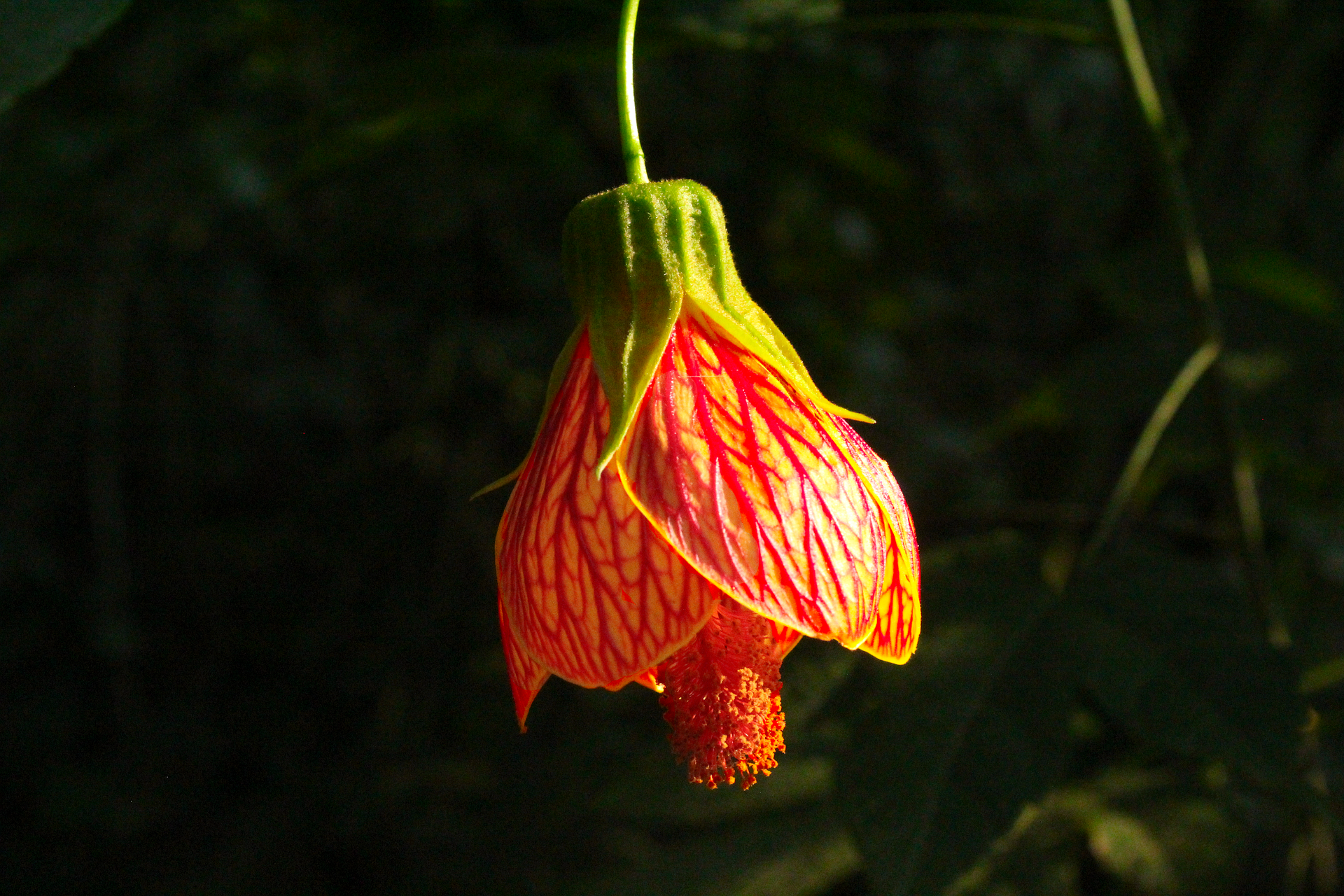
Crossvine (Bignonia capreolata)
It’s a climber! Thanks to adhesive pads at the ends of its tendrils, Crossvine can work its way up stone walls without any support.
Growing up to 50ft in length and highly attractive to hummingbirds, you’ll know it if there’s a crossvine in the area. Showy flowers appear mid-spring and each will last for about 4 weeks at a time.
In cooler weather the dark green leaves will turn an attractive reddish-purple color.
Mostly ornamental, you can use the bark from the vine as a bath infusion to treat headaches. Traditional uses for Crossvine held it as a “blood purifier” and recent studies show that there is a compound in the stems that can be used to manage high blood pressure.
You might be able to boil the stems for a tea, but exercise caution as ingesting high amounts of Crossvine can be toxic. If your skin reacts to handling the vine, it isn’t advisable to consume it.
Key Identifying Features
Easily confused with Trumpet Creeper Vine (See below)
Flowers:
- Orange-red on the outside
- Yellow on the inside
- Trumpet-shaped
- Clusters of 2-5
Seeds:
- Brown, flat seed capsules
- Capsules are 4-8in long
Leaves:
- Dark green in warm weather
- Reddish purple in winter
General:
- Woody stems up to 50ft long
- Cutting stems open reveals a cross shape on the inside
Here is how to identify Crossvine (Bignonia capreolata)
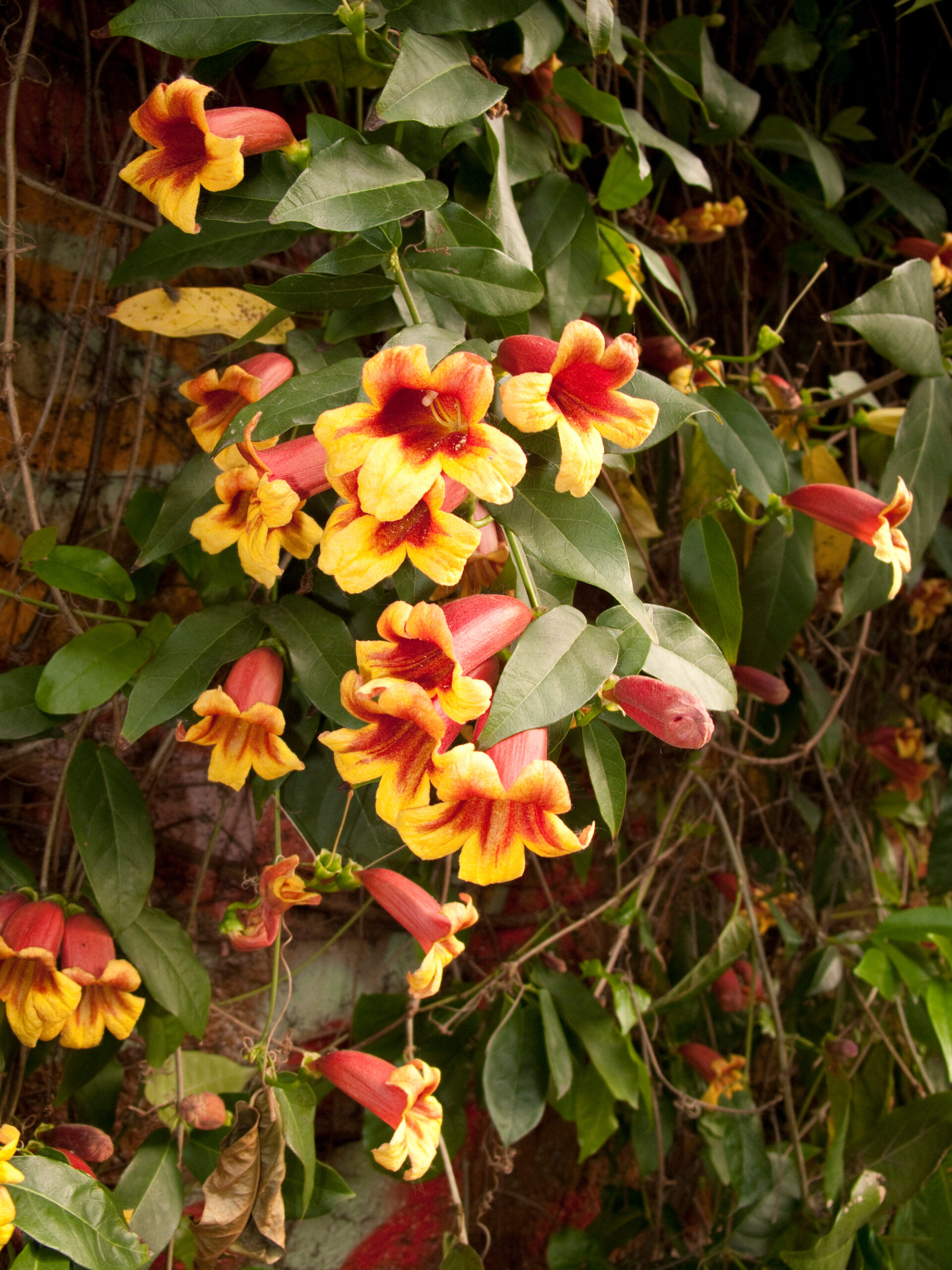
Jewelweed (Impatiens capensis)
While “weed” is not a very nice name, it’s an apt description of how Jewelweed grows. Anywhere you might expect moist soil and shady conditions, this plant will appear in droves—ditches, bogs, ruts near hiking trails, etc.
It’s competitive and can even go toe-to-toe with the highly invasive garlic mustard plant. Jewelweed spreads by firing its seeds out of its pods when touched (literally), which is what gave rise to its other name, touch-me-not.
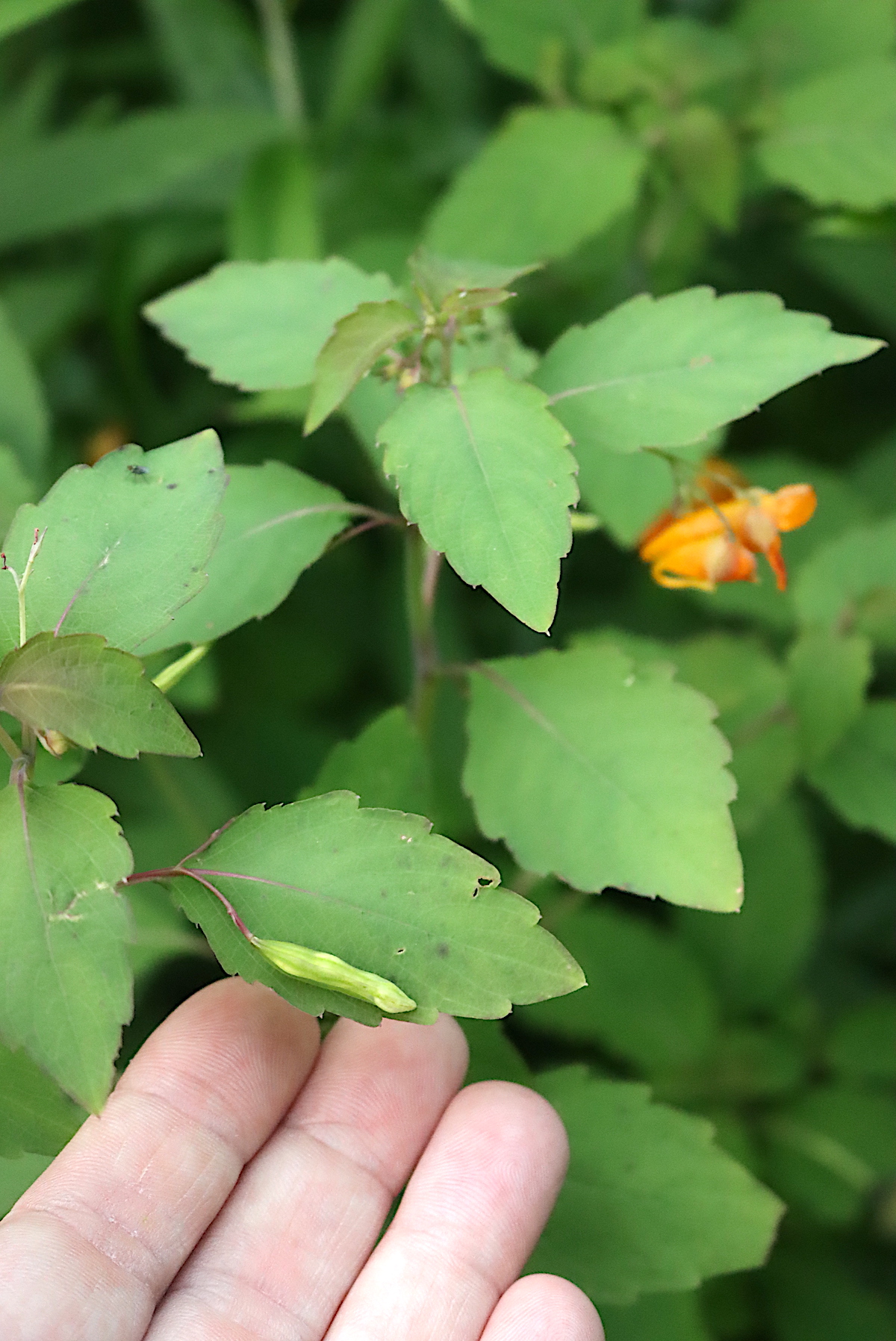
But Jewelweed doesn’t deserve the same treatment as other weeds: it’s a beautiful plant, edible, and fun too!
The delicate flowers and touchy seed pods are an excellent snack, and you can cook the young leaves or stems as a potherb.
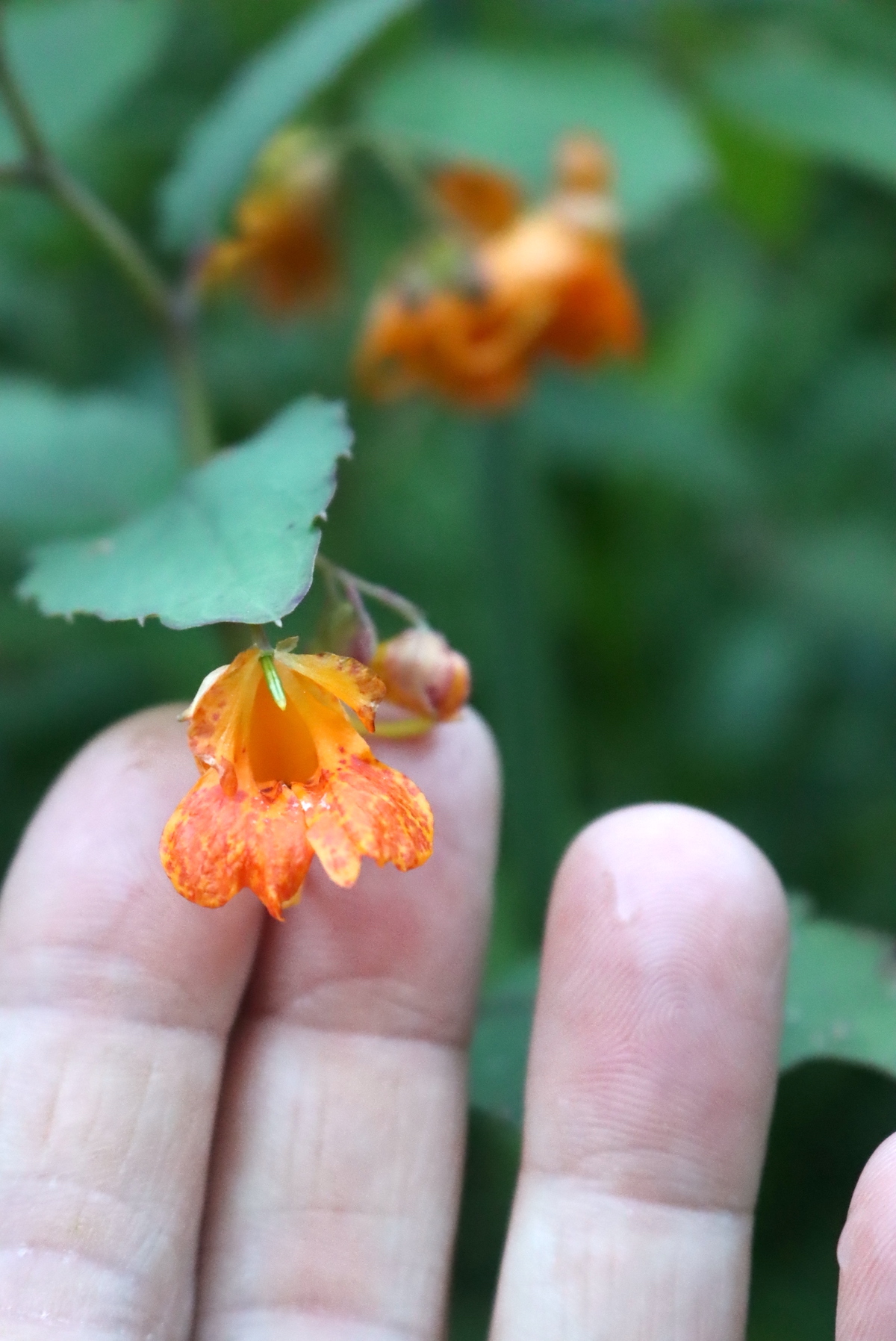
Broken stems can act as delicate straws for an afternoon. Sap from the leaves and stems can be used to soothe irritated skin, including poison ivy, and act as an antifungal in treating athlete’s foot.
When looking for Jewelweed, start by searching for low-growing masses of similar plants. In midsummer, you can start looking for the distinct orange flowers on the tips of each stem—some plants have similar flower shapes but aren’t orange—and you can keep checking until your area sees frost.
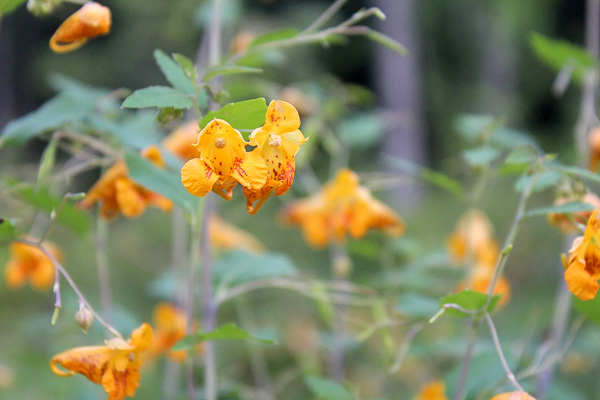
Key identifying features
Jewel Weed looks similar to the Pale-Touch-Me-Not. You’ll only really be able to tell the difference when the two plants are flowering.
Himalayan Balsam can also be confused for Jewel Weed due to their similar flower shape. You’ll know it’s Balsam by its purple flowers and the musty smell coming from its crushed leaves.
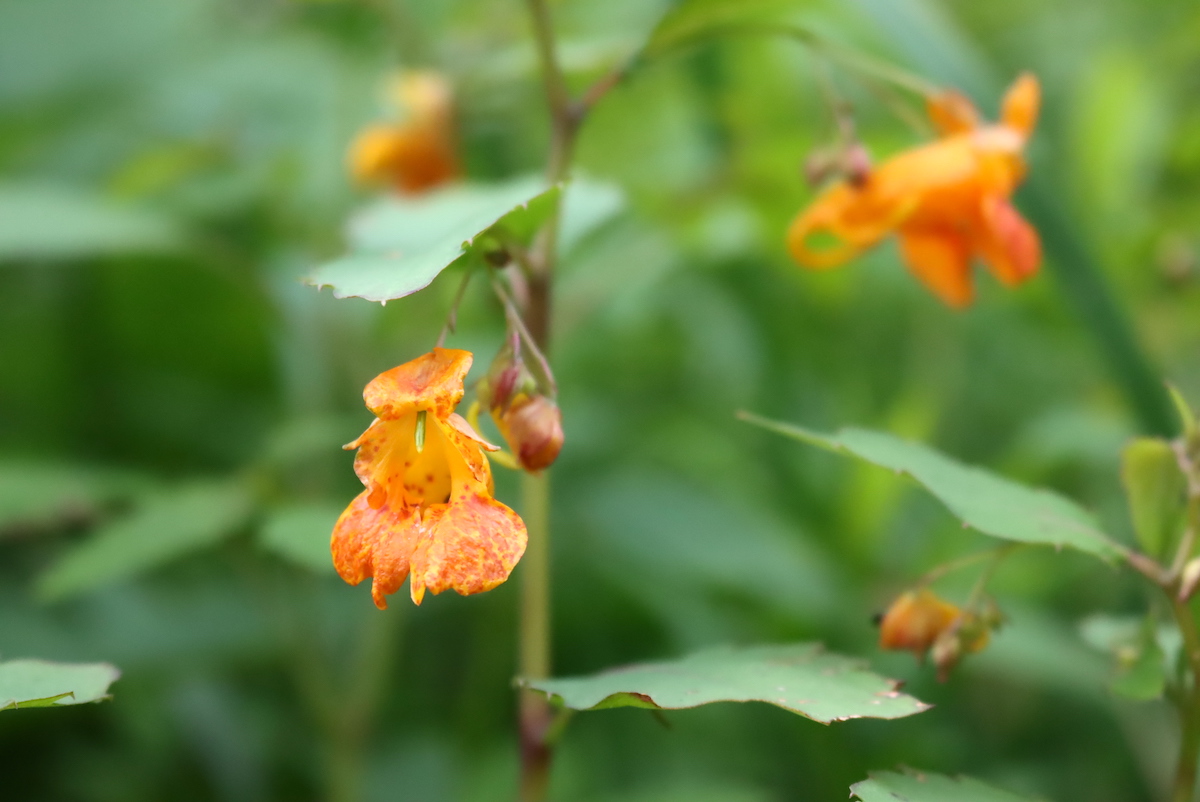
Flowers:
- 1in long
- 3 lobed corolla formed out of 5 petals
- Curled spur at the back of the flower
- Petals form a small tubular pouch
- Form at the ends of solitary stalks
- Bright red-orange flecks all over
Seeds:
- Small green capsules
- Elongated shape to capsules
- Highly sensitive to touch
Leaves:
- Oval shaped with toothed edges
- Dew and rain beads up on them
- Well spaced
General:
- Weak, watery stems
- Smooth, translucent, hollow stems
- Stems are pale green to reddish green
- Stems and leaves look silvery when submerged in water
Here is how to identify Jewelweed (Impatiens capensis)
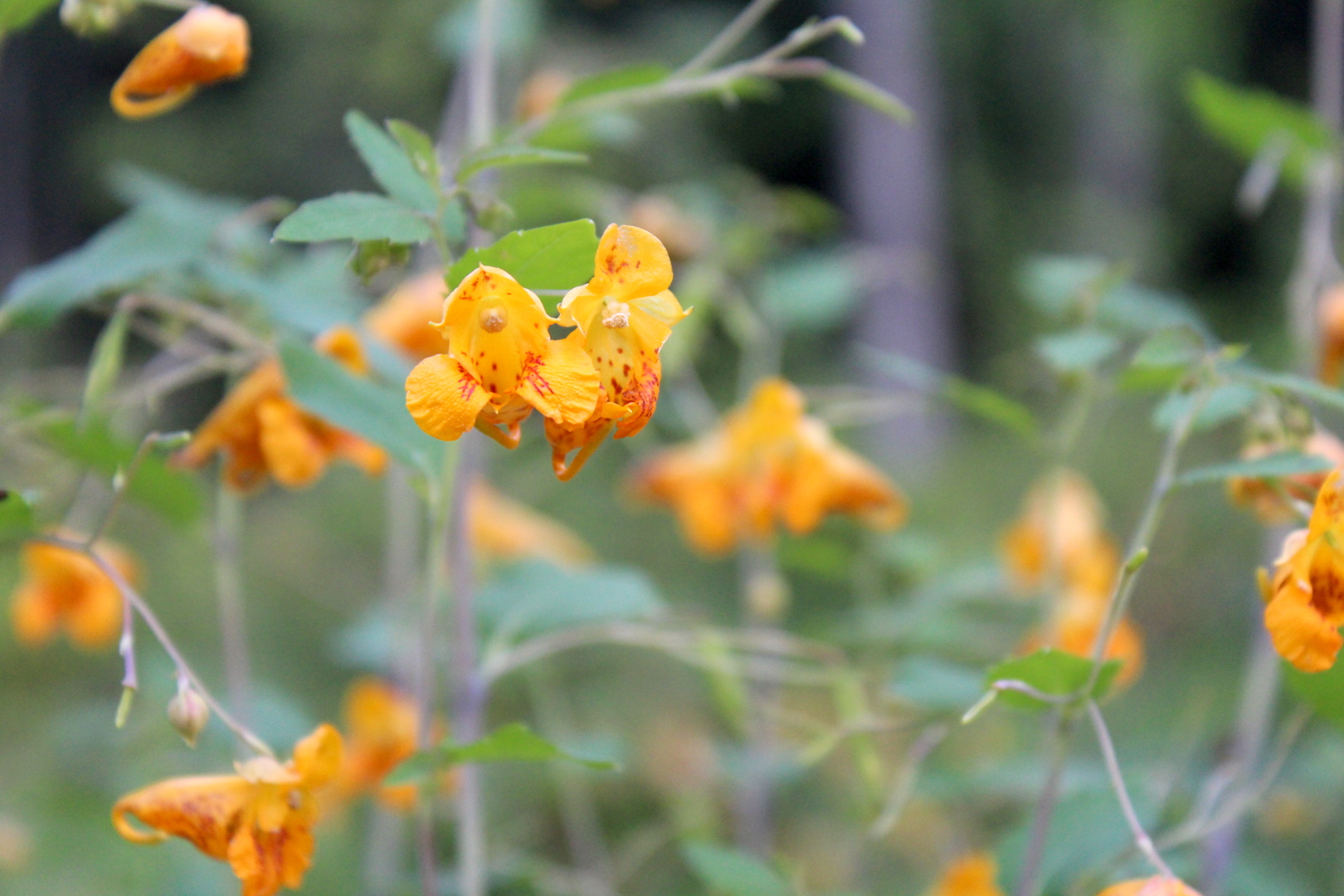
Morning Glory (Ipomoea coccinea)
Most of us could probably identify a local Morning Glory. But with hundreds of species sharing this name (and each species coming with dozens of varieties), pinning down what kind of morning glory you’re looking at is tricky at best.
In general, morning glories are vines that enjoy climbing up to 10ft in height or running their stems along the ground. Beautiful trumpet-shaped flowers open early in the morning and come in a variety of colors.
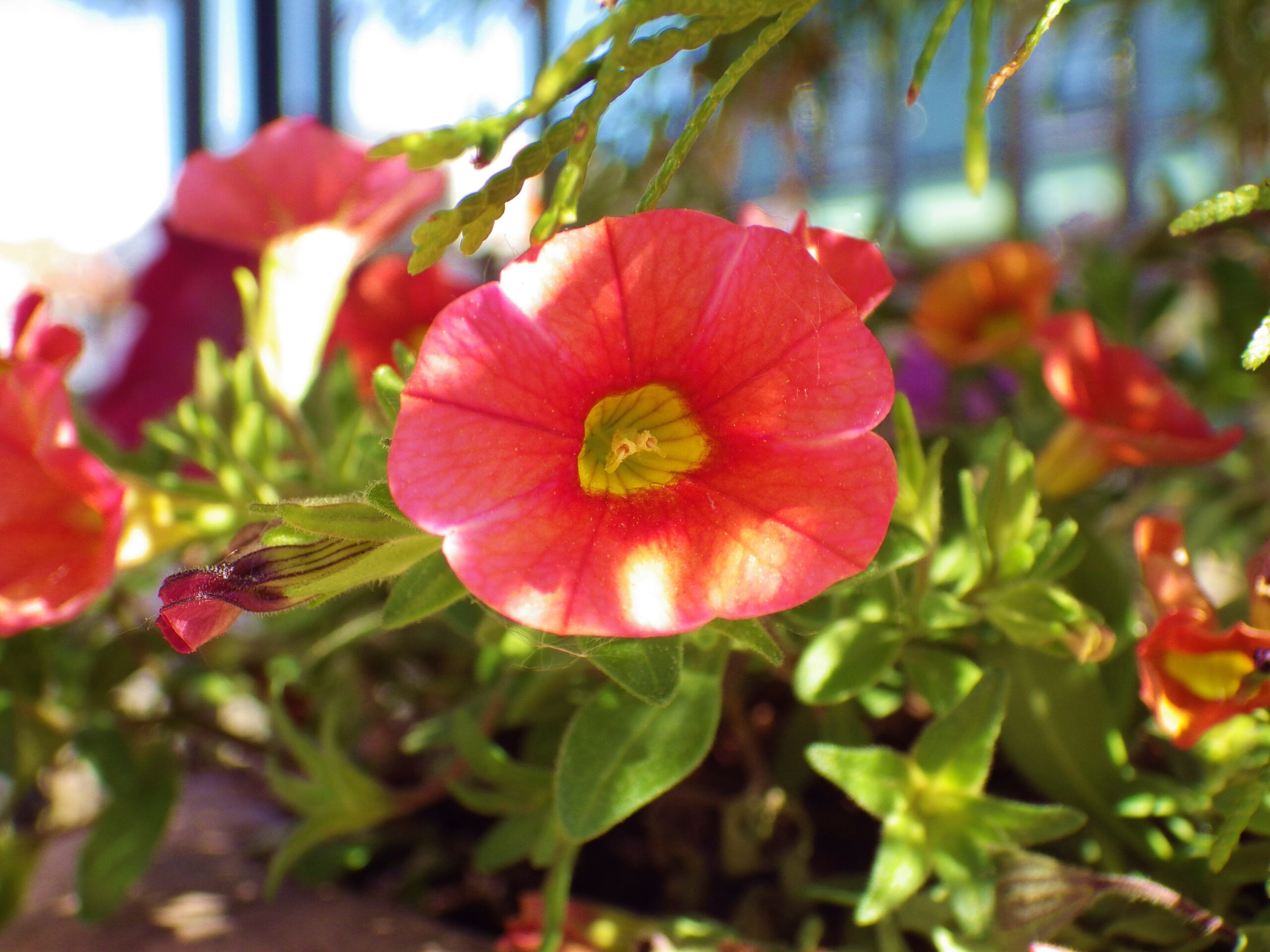
You’ll find their leaves are usually heart-shaped and can be whole or lobed. Popular uses for this plant are as an ornamental or on shade structures. But be careful when adding it to your garden—they can be extremely difficult to remove!
Morning glories range from being completely toxic to edible and medicinal. The orange variety is not edible (usually), and its seeds contain a mild hallucinogenic. If you ever encounter one in the wild and want to know for certain, check with an expert in your area who can help identify which specific genus you’re dealing with.
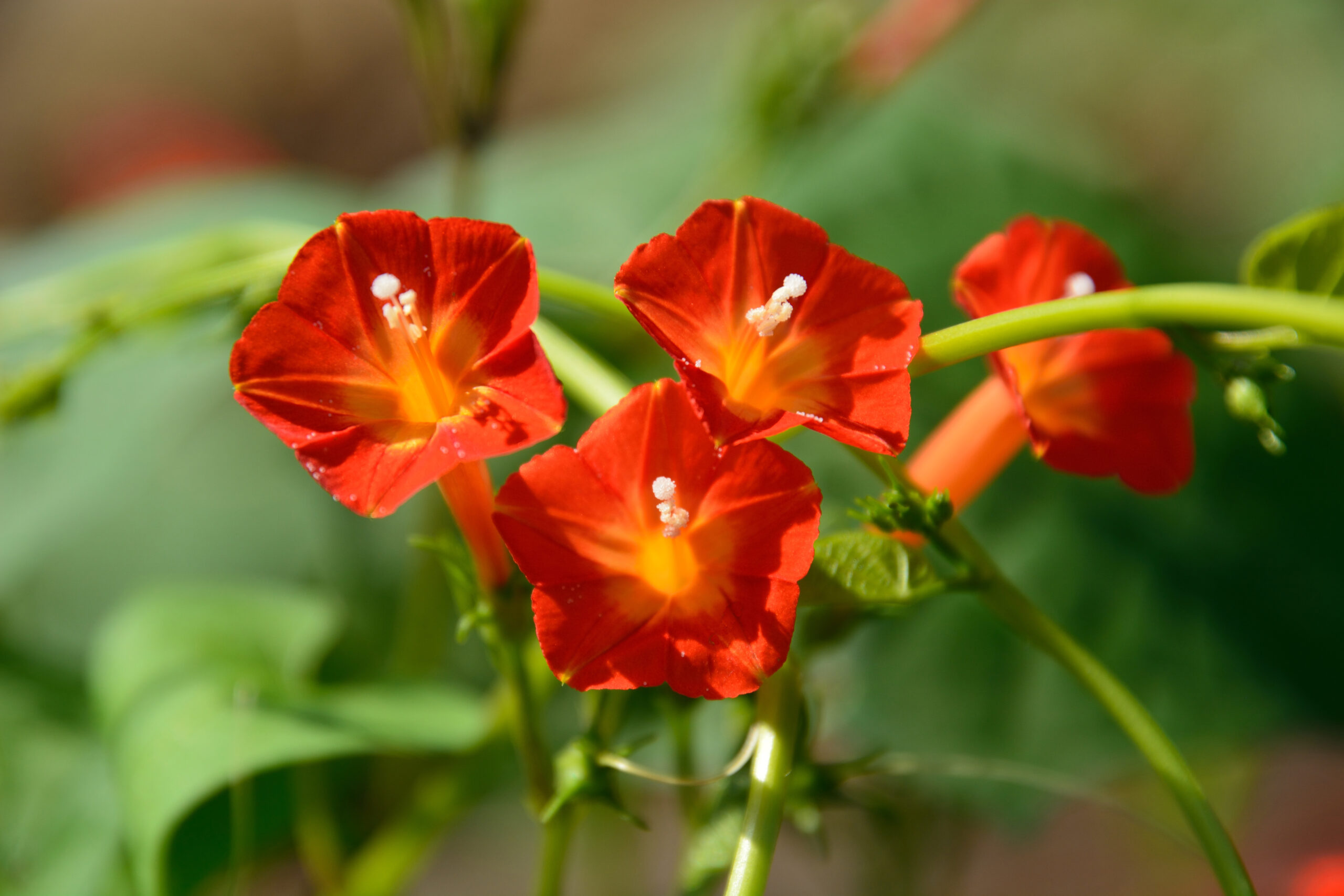
Key identifying features
There are two other plants often confused for the Orange Morning Glory: Cypress Vine (Ipomoea quamoclit) and Scarlet Morning Glory (Ipomoea hederifolia). Both of these plants bear flowers that are a brighter red than the coccinea species, but some varieties will look paler or have hints of orange in them. You can easily distinguish Cypress Vine by the fern-like shape of its leaves. But you may need an expert to help distinguish between Scarlet and Orange morning glories.
Flowers:
- Dull red edges with an orange throat or fully orange
- Trumpet-shaped
- 5 pointed star shape at center
- Clusters of up to 6 flowers
Seeds:
- Spherical, brownish-black capsules
- Brittle pods break when they hit the ground
General:
- Heart-shaped leaves
- Stems tangled
- Leaves can have 0-5 lobes
Here is how to identify Morning Glory (Ipomoea coccinea)
Orange Daylily (Hemerocallis fulva)
An excellent gift to pollinators and foragers alike, Orange Daylilies will happily spread anywhere they can get enough water and sunlight. Considered invasive in many parts of the U.S., the best way to control their population is to dig them up and eat them!
Young leaves and shoots can be cooked and eaten as an asparagus or celery substitute. Both the tubers and flowers are edible when raw or cooked. In Asia, where the flower originates, the buds are considered the delicacy of this plant when added to stir fries.
Older blooms can be dried and crushed to use as a soup thickener. And as the plant dies back in the winter, the dried foliage can be braided into a cord.
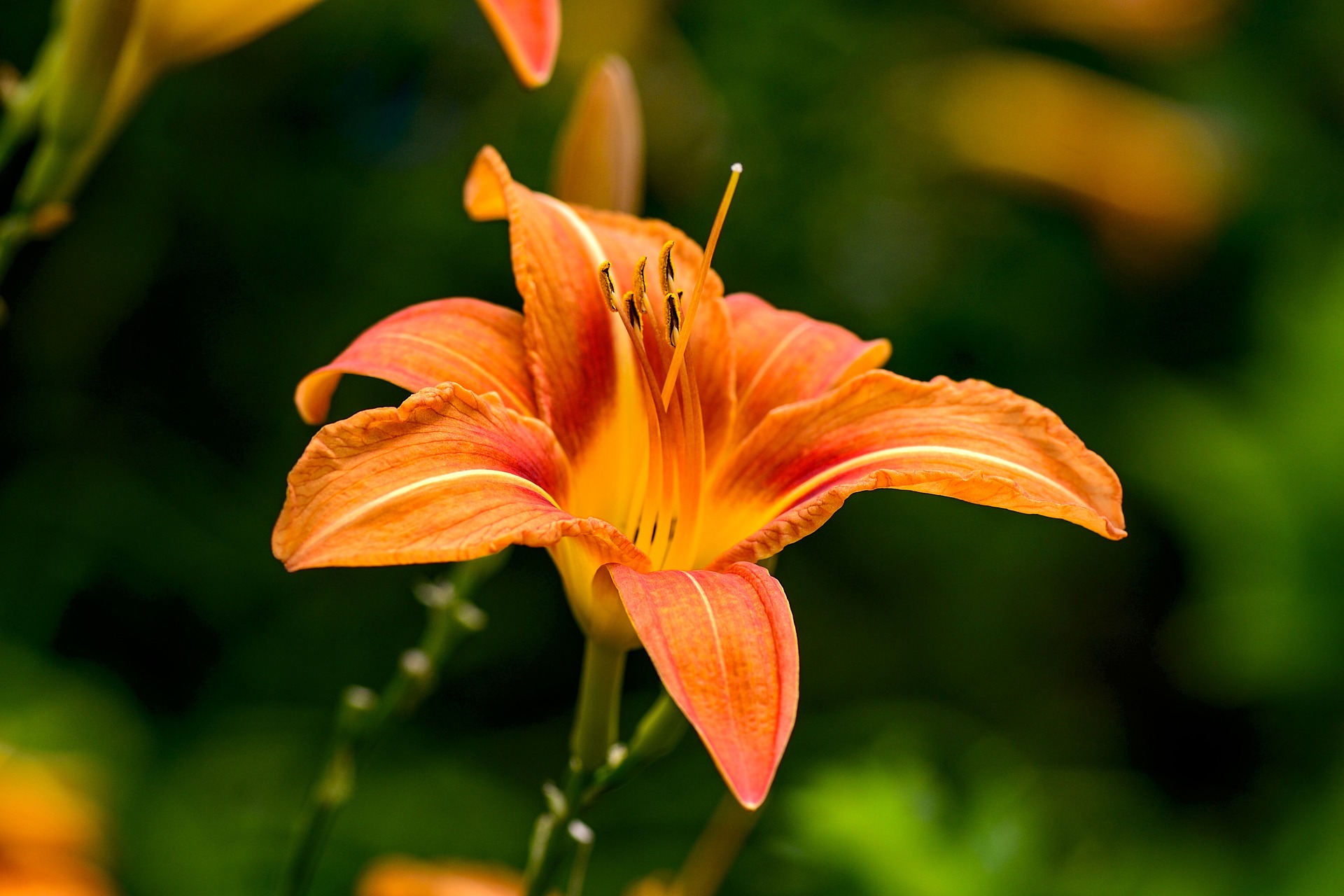
No parts of Orange Daylilies are toxic to humans (cats beware!) but they are easily confused with more toxic plants. Some foragers have reported gastric distress after eating Daylilies, though this is rare and may be due to eating a fully mature plant. Many traditional Asian recipes for Daylilies call for them to be soaked and blanched before eating—which may be a good tactic to try with any Daylilies you forage.
You’ll spot Daylilies growing in well-drained, sunny areas. Look for the tall flowers that sit up to 6ft in the air on their bare stalks. While they produce seeds, Daylilies are infertile and spread through their roots. So look for larger clumps of plants in the spring, summer, and fall.
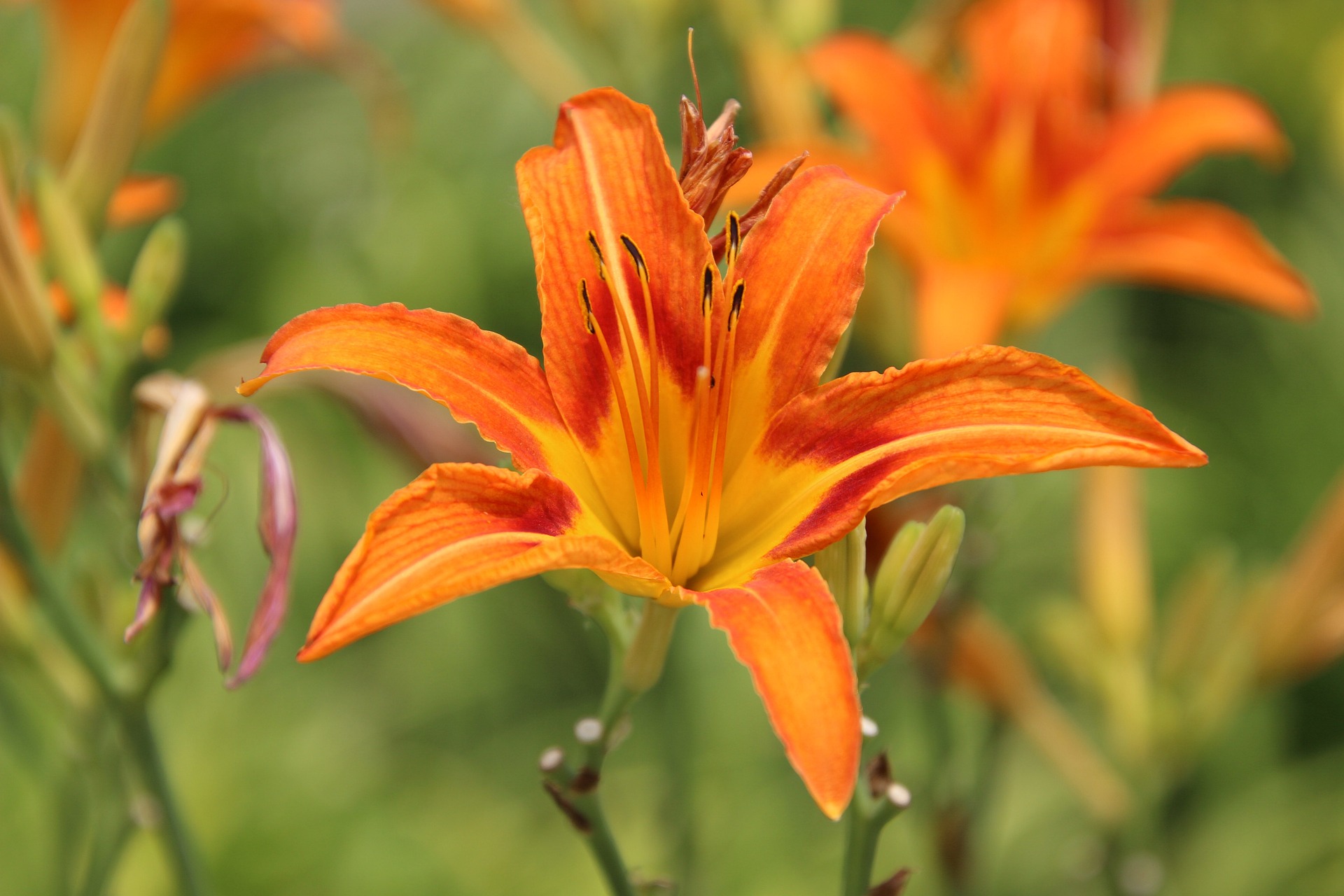
Key identifying features
Daylilies are not Lilies proper but certainly look a great deal like them. The easiest way to differentiate is to look at the foliage: Lilies will have flowers and leaves on the same stalk while Daylilies only flower on a bare stalk. Additionally, Lilies on the same stalk will flower all at once and last for 5-7 days. Daylilies, as is in their name, bloom for a single day before dying back and letting another flower hold the spotlight.
If the plant in question isn’t showing flowers yet, you may confuse Daylilies with non-native Lilyturf—another Asiatic transplant that looks like but isn’t related to the lily family. Lilyturf flower stalks don’t get as tall, and the plant doesn’t fully die back in the winter. But when in doubt, let it flower out.
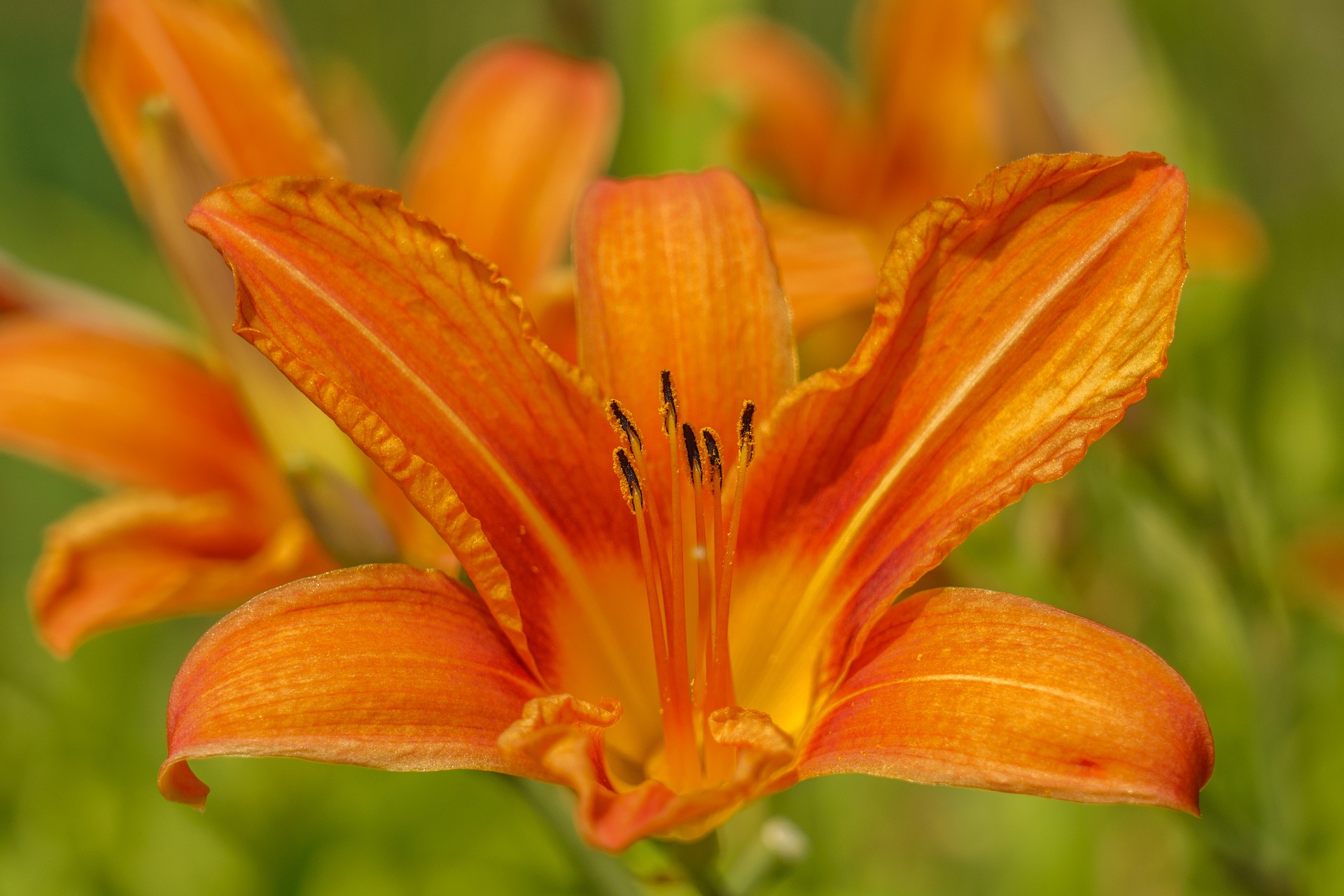
Flowers:
- Buds are green to greenish orange
- Open for 1 day
- Clusters of 5-6 buds at the end of each stem
- 6 petals
- Lily-shaped
- Orange edges, lighter to yellow center
Seeds:
- 3 celled cylindrical capsules
Leaves:
- Wide grass-blade shape
- Grow at the base of the plant
- 2-3ft long
- Bright green
Here is how to identify Orange Daylily (Hemerocallis fulva)
Orange Evening Primrose (Oenothera versicolor)
In its own way, the Orange variant of Evening Primrose is a bit of a rebel. Unlike most of the nocturnal family, the Orange flowers open up to greet the day and close up for the night. You’ll spot it growing in clumps with the younger Primroses still low to the ground in a rosette. After the first year of growth, Orange Evening Primroses send up a long spiky-looking stalk. In summer and early autumn the flowers at the tip-top of these spikes will hover at about eye-level.
While the flowers, stalks, leaves, and buds are edible, you don’t need to wait a whole year to enjoy the Evening Primrose: the young tuberous roots are also edible! More mature roots won’t be as palatable, so you’ll want to get them early. If you’re willing to be patient, letting the plant mature will allow you to harvest oil from these plants by pressing the seeds. The leaves that form on the flower stalk are also much tastier than what you can harvest from the first year’s rosette.
Medicinally, Orange Evening Primrose can be used in poultices for bruises or boils. The seed oil has also been historically hailed for helping alleviate a variety of symptoms. Before trying the oil, though, you’ll want to check ahead of time it won’t aggravate any symptoms you have. It’s not recommended if you’re pregnant, breastfeeding, have a bleeding condition or a seizure disorder.
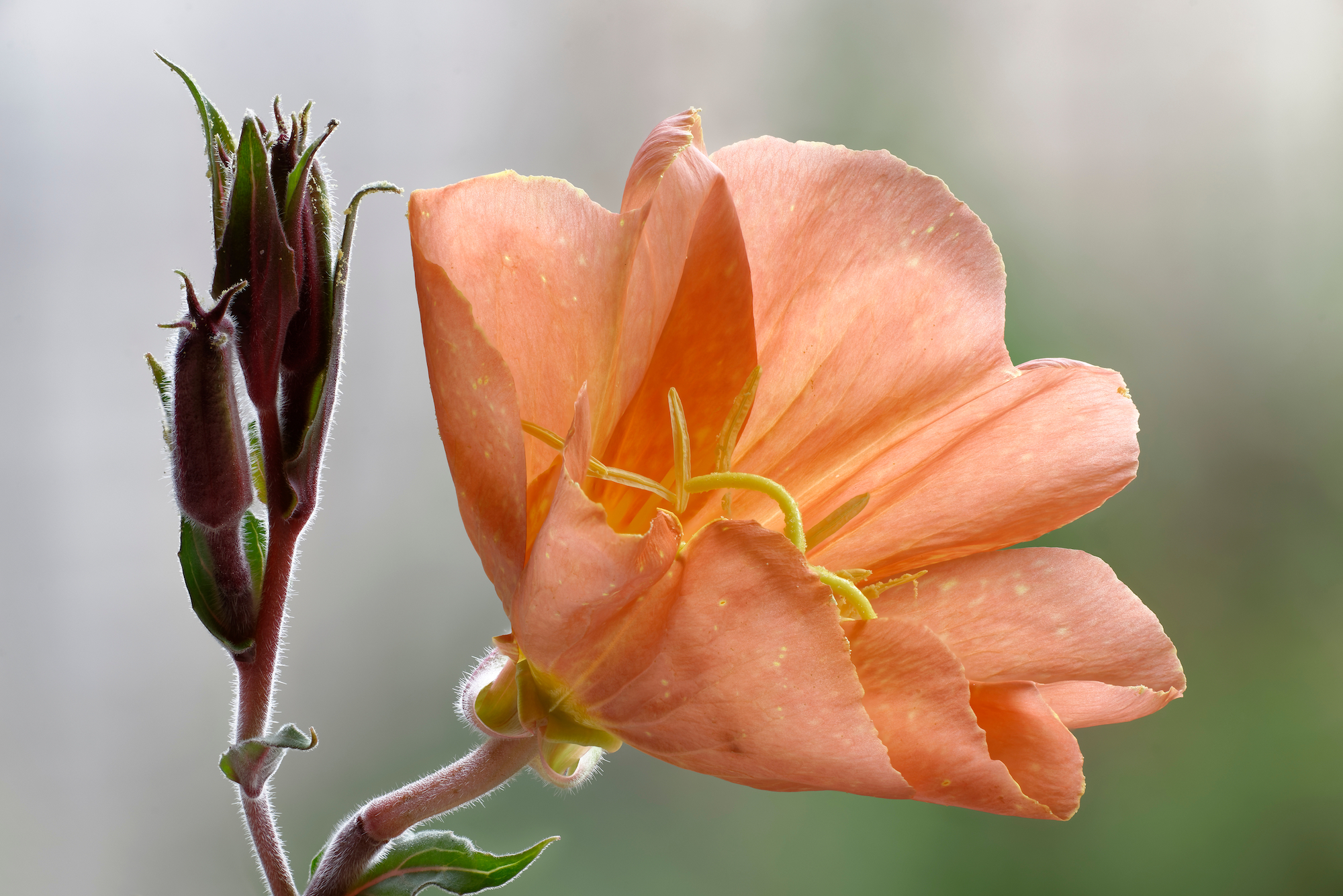
Key identifying features
It’s easy to confuse Orange Evening Primrose with the Narrowleaf variety before the plants have flowered. Narrowleaf plants have a similar general shape but are smaller, form clusters of stems, and have shorter leaves.
Flowers:
- Start orange and fade to red
- Open in the morning and close at night
- Four petals
- Grow in clusters around a spike
Seeds:
- Forms dark colored capsules
- Seed capsules are long, narrow, and woody looking
General:
- One single stalk with no branches
- Leaves have a light green to reddish center line
- 1st year of growing it forms a low rosette
- 1st year leaves are long (7-9 inches)
- 2nd year of growing the high stalk will form
- Leaves on the higher end of the stalk will be smaller (1-2 in)
Here is how to identify Orange Evening Primrose (Oenothera versicolor)
Orange Hawkweed (Hieracium aurantiacum)
If you see a wide swath of what looks like orange dandelions you are most likely looking at Orange Hawkweed. It was originally brought to the Americas from Europe and has since become a nuisance. As it grows, it pushes out other plants and is rapidly rising on the list of plants considered to be highly invasive.
You’ll find it happily growing in almost any patch of sunny, disturbed soil in the northern states.
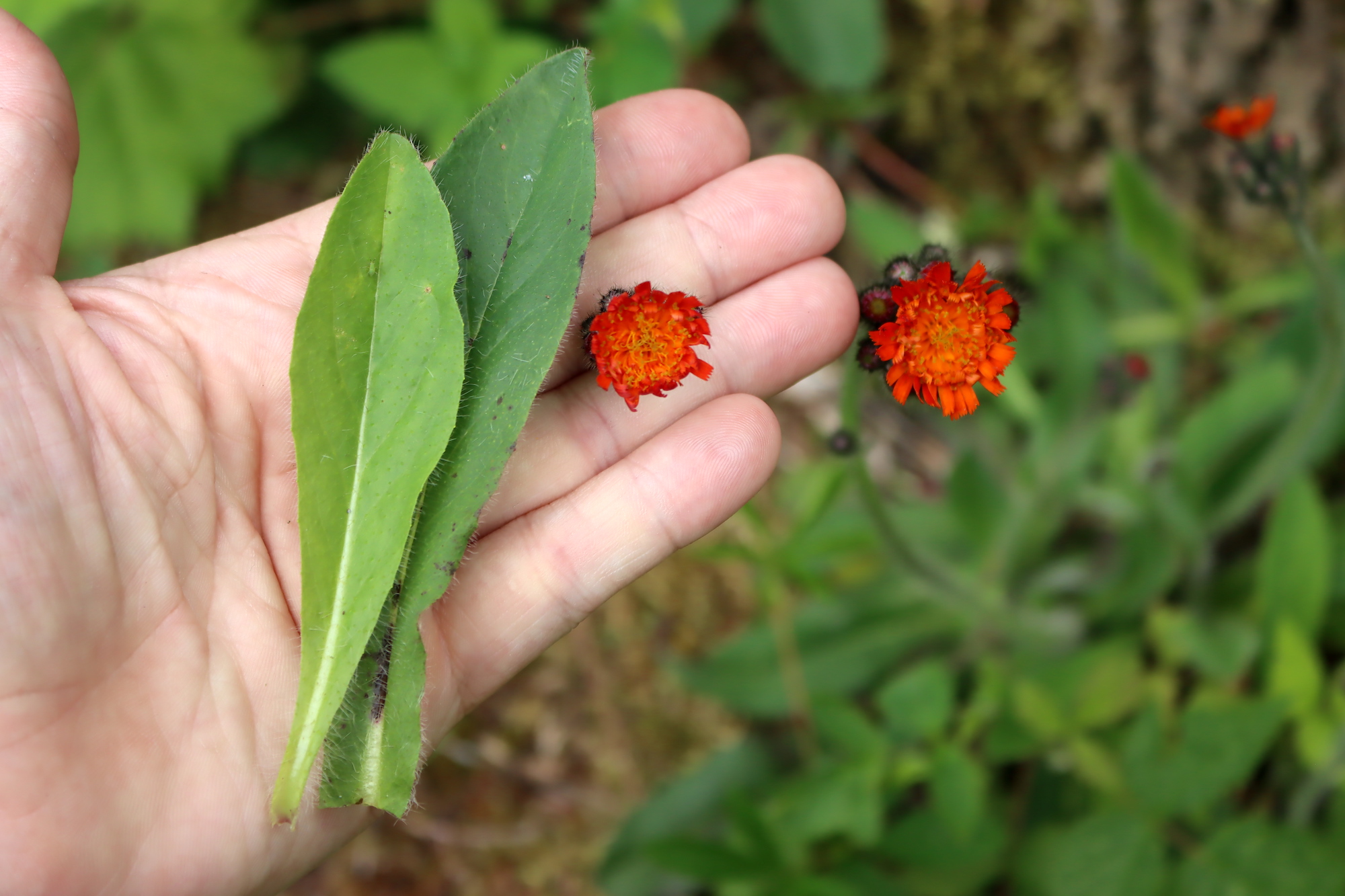
Once the flowers die back, a seed head forms that also looks a lot like a dandelion (though the two plants aren’t related)—white tufts protrude from the dark center that make the seeds good at hitchhiking.
If you see a patch of Orange Hawkweed encroaching on your yard, you’ll want to remove it before it goes to seed. Once settled, the seeds are viable for up to 7 years!
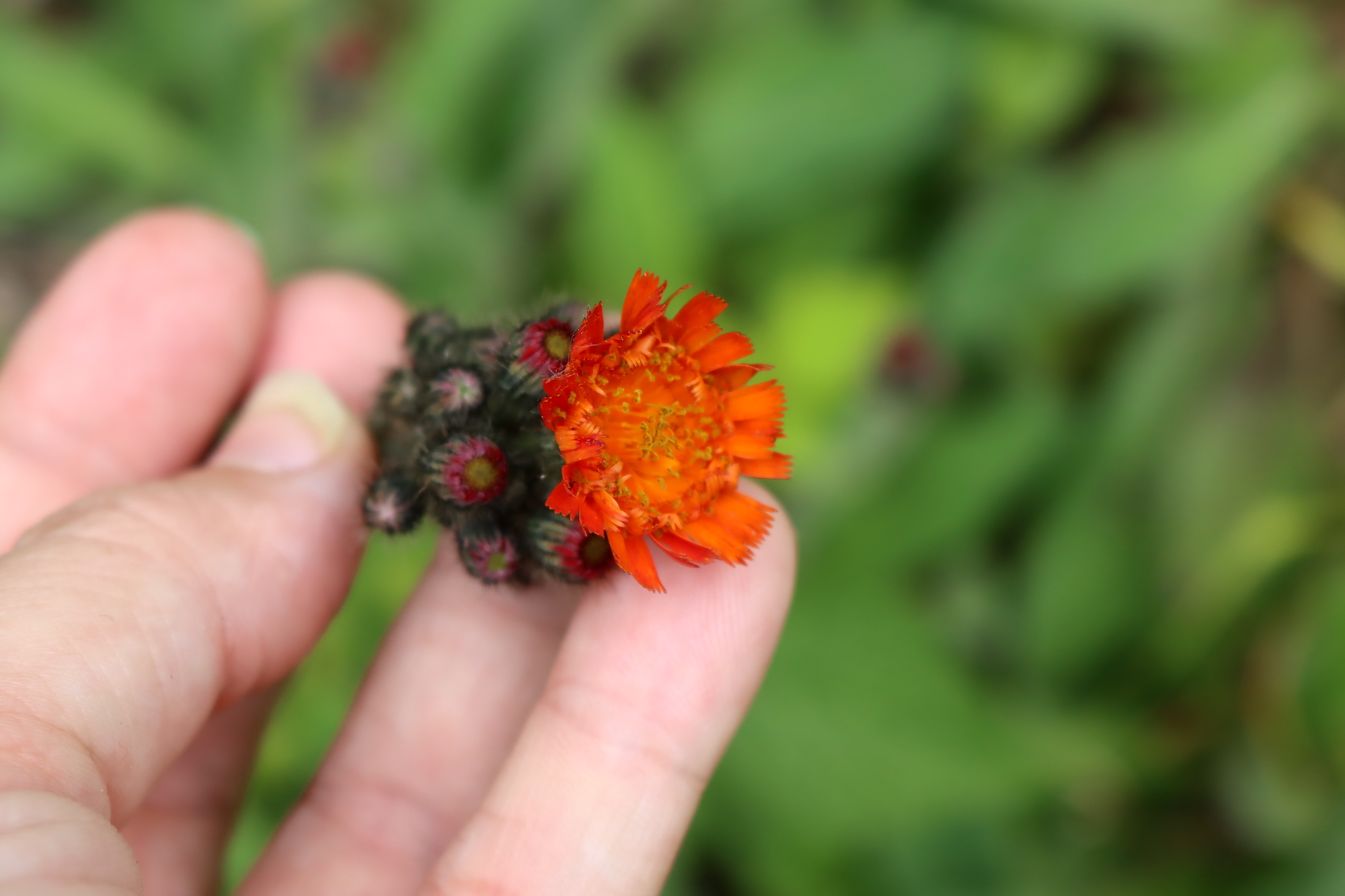
Key identifying features
Sticky Hawkweed and Narrow-leaf Hawkweed look similar to Orange Hawkweed in shape but produce yellow flowers and will have leaves all the way up the stalk instead of just at the base.
Meadow Hawkweed also looks similar and produces yellow flowers but it has multiple stalks growing from each rosette.
And the last plant you may mix-up with Orange Hawkweed is Glaucous King-Devil which does not produce dandelion puff seed heads and also has yellow flowers. Your best bet for finding the right Hawkweed is to look for the orange flowers!
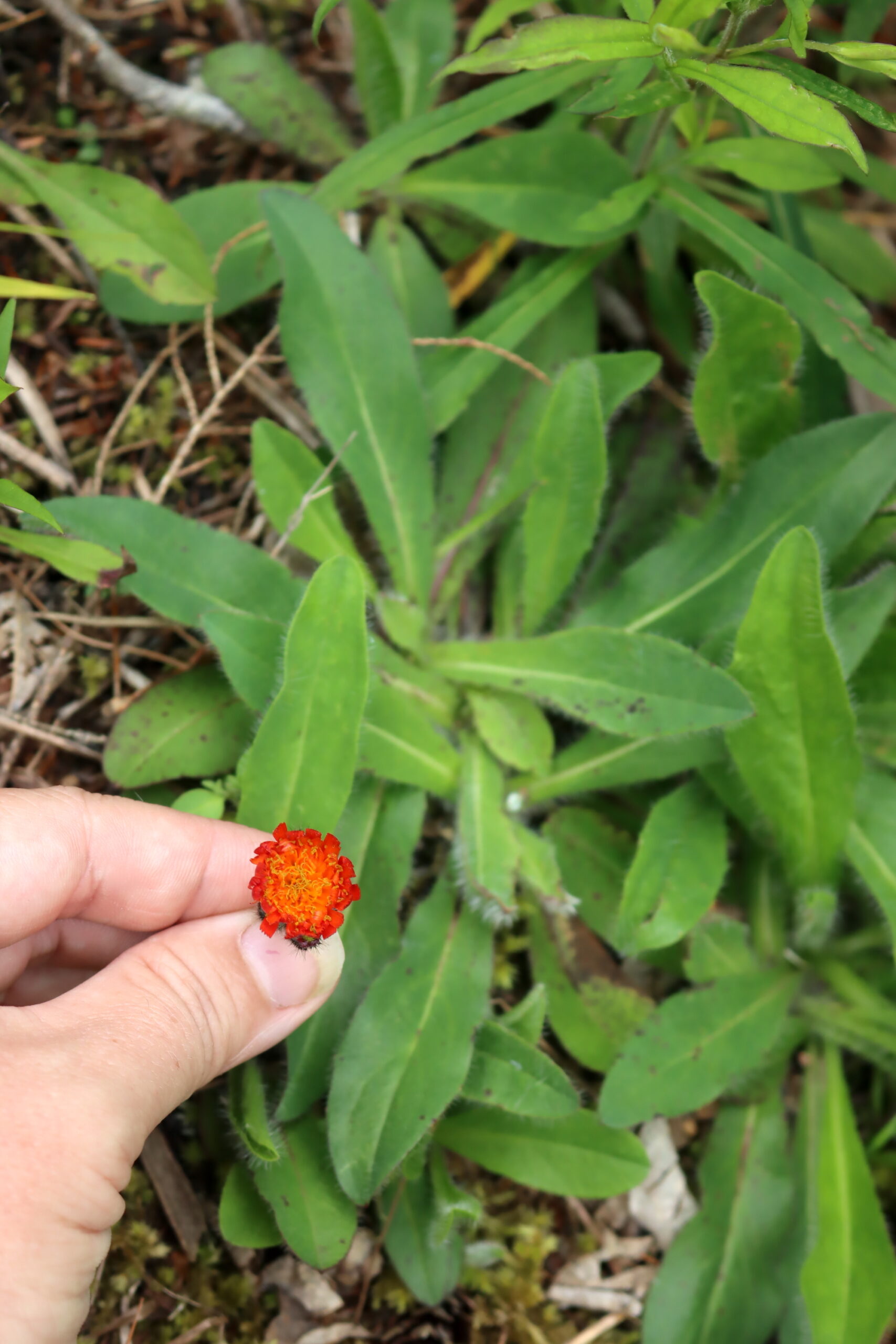
Flowers:
- Form at the top of stalks
- Dandelion-shaped
- Clusters of 5+ flowers
- Rectangular petals
- Toothed petals
Seeds:
- Dandelion-shaped
- 12-30 white seeds on the seed head
- Small barbs on each seed
Leaves:
- Leaves in a rosette at the base
- Hairy leaves 4-6in long
- Spatula-shaped leaves
- Dark green on top, light green below
General:
- Stalks are bare of leaves
- Hairy stems
- One stalk per rosette
- Milky sap
Here is how to identify Orange Hawkweed (Hieracium aurantiacum)
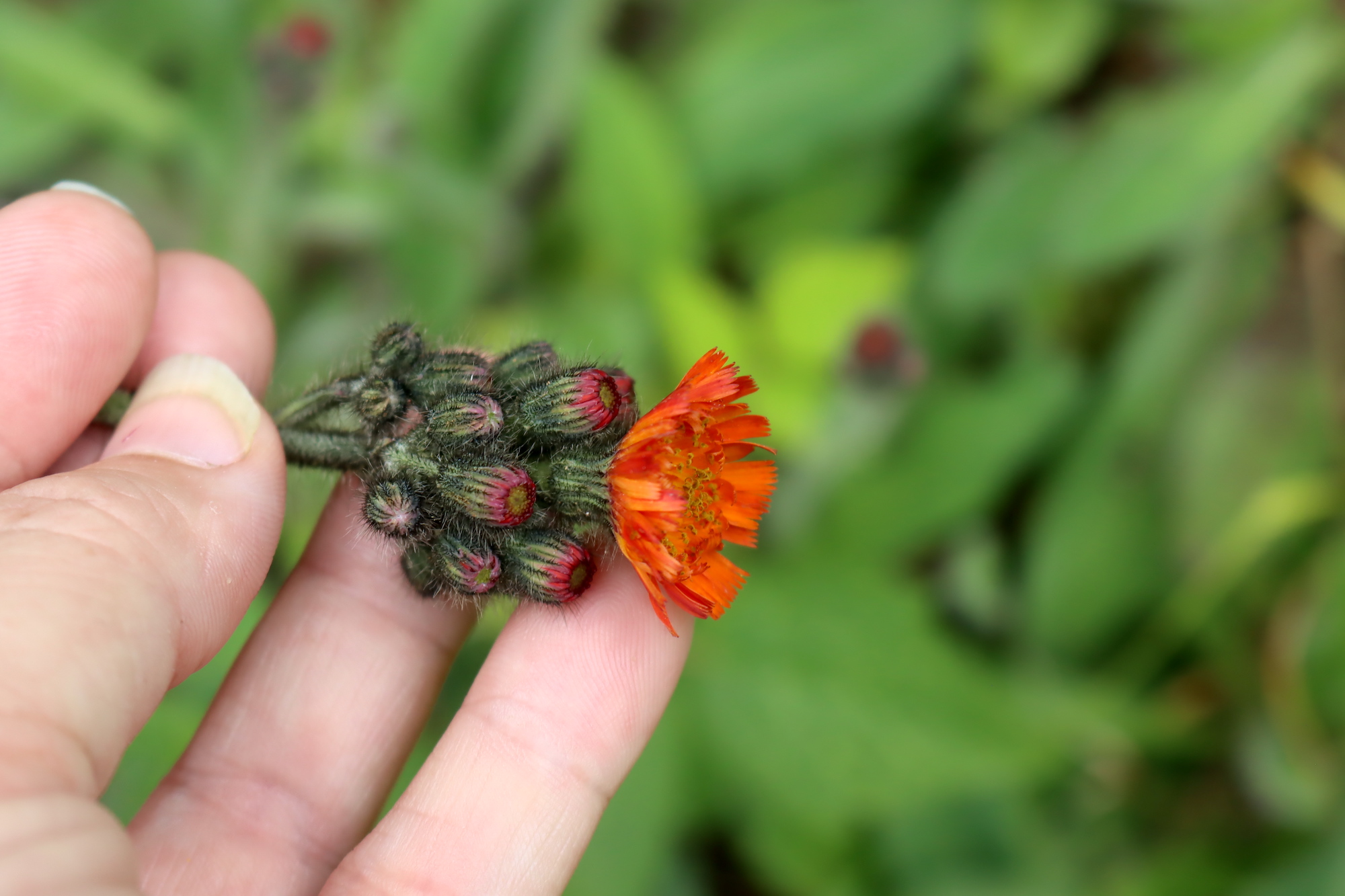
Orange Nasturtium (Tropaeolum sp.)
You’ll want this plant in your garden! Not only is Orange Nasturtium beautiful, it’s edible, and highly attractive and resistant to aphids. Settle it next to any plants you want to protect from aphids and they’ll swarm to the Nasturtium instead—an easy, organic, pest control! You can also use it to repel other insects (including the dreaded Squash Bug), though you’ll need to be prepared to plant a lot of Nasturtiums.
Nasturtium flowers are best eaten raw as they tend to fall apart when heat is applied to them. There is a spur on the flowers full of nectar that you may want to remove as it usually has insects inside. Raw leaves from this plant have a nice, peppery taste (as does most of the plant). The seeds are edible and can be pickled for use as a caper alternative when fresh, or ground as a pepper alternative when dried. In Asia, teas made from the petals and buds are said to help alleviate symptoms from the common cold.
In North America, you can expect Nasturtiums to grow wild along the coasts as they are sensitive to frost. Keep a sharp eye out for the large round leaves but don’t expect to find this plant by its shape—it enjoys growing as a bush, trailer, or even a climber!
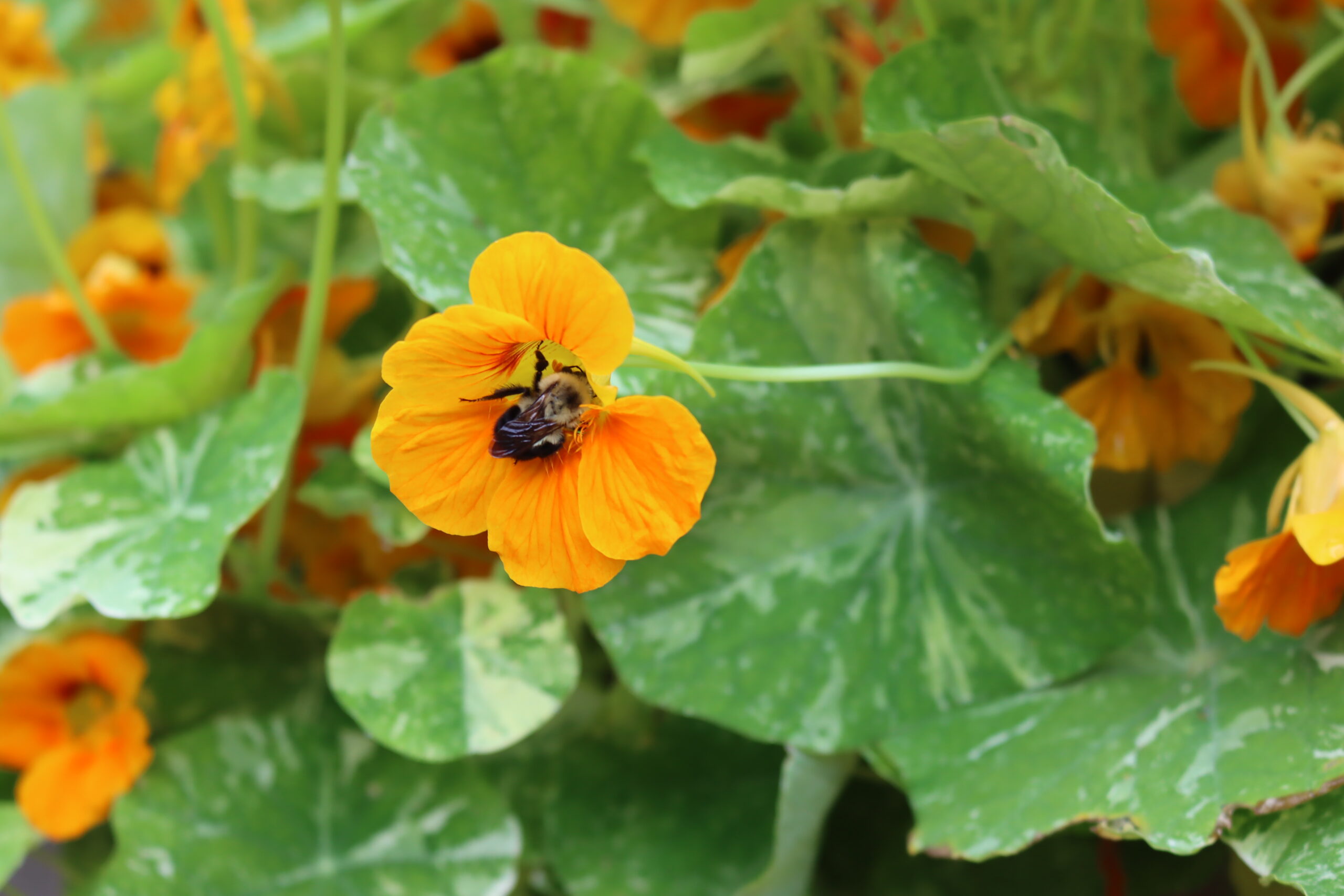
Key identifying features
Flowers:
- Five broad petals
- Funnel-shaped
- Thin and velvety petals
- A few central yellow stamens
Seeds:
- Trilobed fruits contain 1 seed per lobe
- Light brown when dried
- Light green when fresh
- Peppercorn-shaped
Leaves:
- Similar to rounded lotus leaves
- One per stem
- 8 white lines radiating out from the center
- Form at the tip of each stem
- Wavy to smooth edges
Here is how to identify Orange Nasturtium (Tropaeolum sp.)
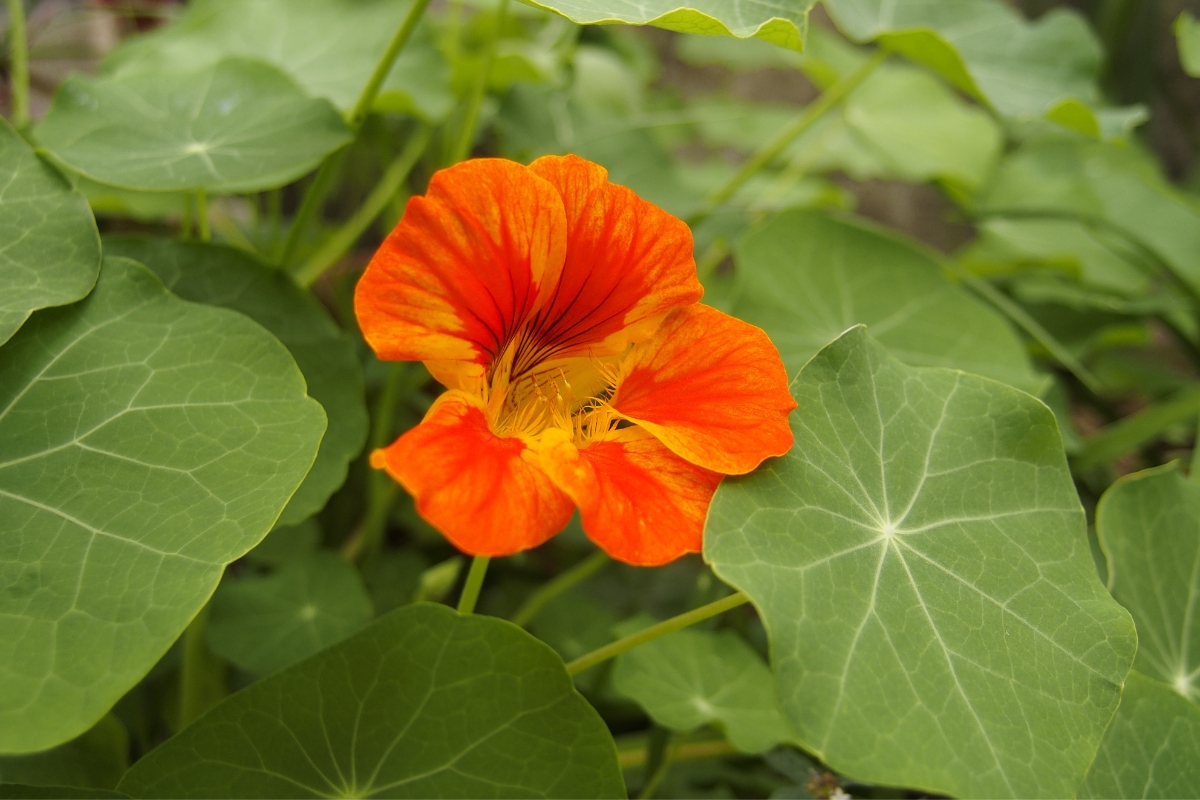
Oriental Bittersweet Vine (Celastrus orbiculatus)
Growing in blankets across open landscapes or winding its way up trees to try and find light, you won’t have any trouble spotting Oriental Bittersweet. Introduced to North America in the late 1800s, this vine has become highly invasive in the years since. Sadly, it’s very easy to confuse with the native American Bittersweet Vine which has contributed to its continued spread and the native version’s decline.
When cooked or brewed as a tea, the leaves of Oriental Bittersweet are edible and have mild anti-inflammatory properties. In America, the most common use for this vine is as a dried material in wreaths where the fruit adds a bright pop of color. Seeds from these wreaths have been known to germinate once the wreath has been discarded and the decorative use of Oriental Bittersweet is highly discouraged for this reason.
Key identifying features
Easily mixed up with the American Bittersweet, you’ll want to look to the leaves to tell the difference. The American variety has football-shaped leaves instead of round and the flowers and fruits form at the ends of the stems. Where the Oriental Bittersweet has yellow-skinned fruit, the American variety has red fruits.
Flowers:
- 2-3 at the base of each leaf
- ½ inch long
- 5 spreading petals
Seeds:
- Bears yellow-skinned fruit
- Yellow skin breaks open to a red center
Leaves:
- Round, serrated
- 3-4 in long
- Turn bright yellow in late summer
General:
- Young growth is bright green and flexible
- Old growth becomes red-brown and woody
- Woody growth has a cracked texture
Here is how to identify Oriental Bittersweet Vine (Celastrus orbiculatus)
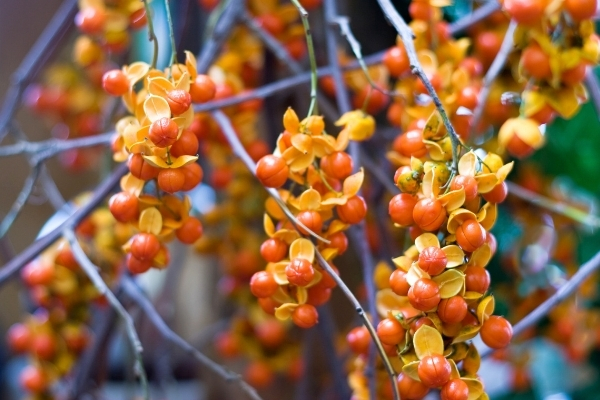
Red Sorrel (Rumex acetosella)
Red Sorrel is excellent friends with Blueberry plants—the two prefer the same growing conditions and can often be found together. Similarly, you’ll often find butterflies like the American Cooper and Small Cooper hovering nearby as these are dependent on the plant. It grows low to the ground, usually not topping 18in when it puts out stalks. So keep your eyes down when out hunting for it!
Encountering the orange variety of Red Sorrel means you’re most likely looking at a male plant. Female Red Sorrel tends to be a true red, but the male plants can have green, yellow, or orange flowers.
The leaves of Red sorrel are edible and have a tart flavor that’s almost lemony. Additionally, they can be used to curdle milk for cheese. Be careful not to overindulge on the leaves—they can become toxic to the kidneys when in excess—and keep it as a garnish or a light flavor additive.
Key identifying features
All variants of Sorrel are commonly confused with Curly Dock as the flowers and shapes of the plants are similar. You can tell the difference by looking for the 2 triangular lobes that grow at the base of Sorrel leaves. Curly Dock doesn’t have the lobes and also tends to branch much lower down on its stalk than Sorrel. Finally, Curly Dock grows significantly taller than Sorrel, up to 5 feet tall.
Flowers:
- Star-shaped
- Tiny
- Grow in branched clusters at the top of stalks
Seeds:
- 3-sided
- Egg-shaped
- Polished mahogany in color
General:
- Rosette shaped base
- Occasional slender stalks
- Branches at the top of stalks
- Red ridges running along stalks
- Arrow-shaped leaves
- Lower leaves have 2 small triangular lobes
Here is how to identify Red Sorrel (Rumex acetosella)
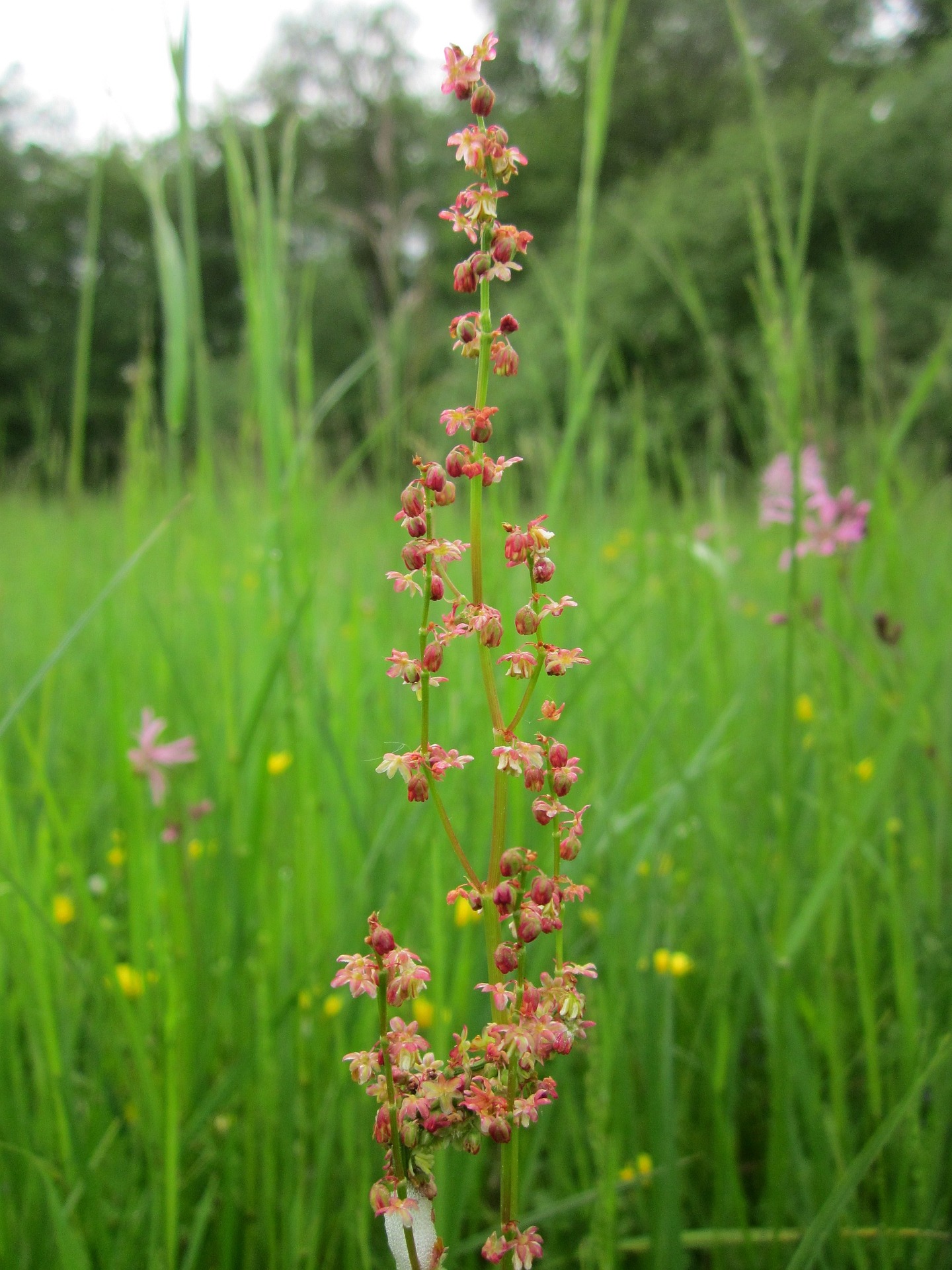
Scarlet Pimpernel (Anagallis arvensis)
A lonely plant, Scarlet Pimpernel can’t compete with most other plants and tends to seek out areas where it can enjoy the sun alone. You’ll find it growing “lying down” most of the time with its stems stretched out along the ground. Best known for its vibrant flowers, you’ll only find them blooming in Spring to early summer.
Scarlet Pimpernel is an ornamental plant. Although you can eat its leaves, it’s generally advised that you cook them first and only consume small quantities at a time. That might not be much of an issue, though—the leaves are bitter and difficult to palate on a good day. Scarlet Pimpernel has been known to be toxic to livestock (and occasionally humans) and it’s theorized it becomes more toxic in rainier weather.
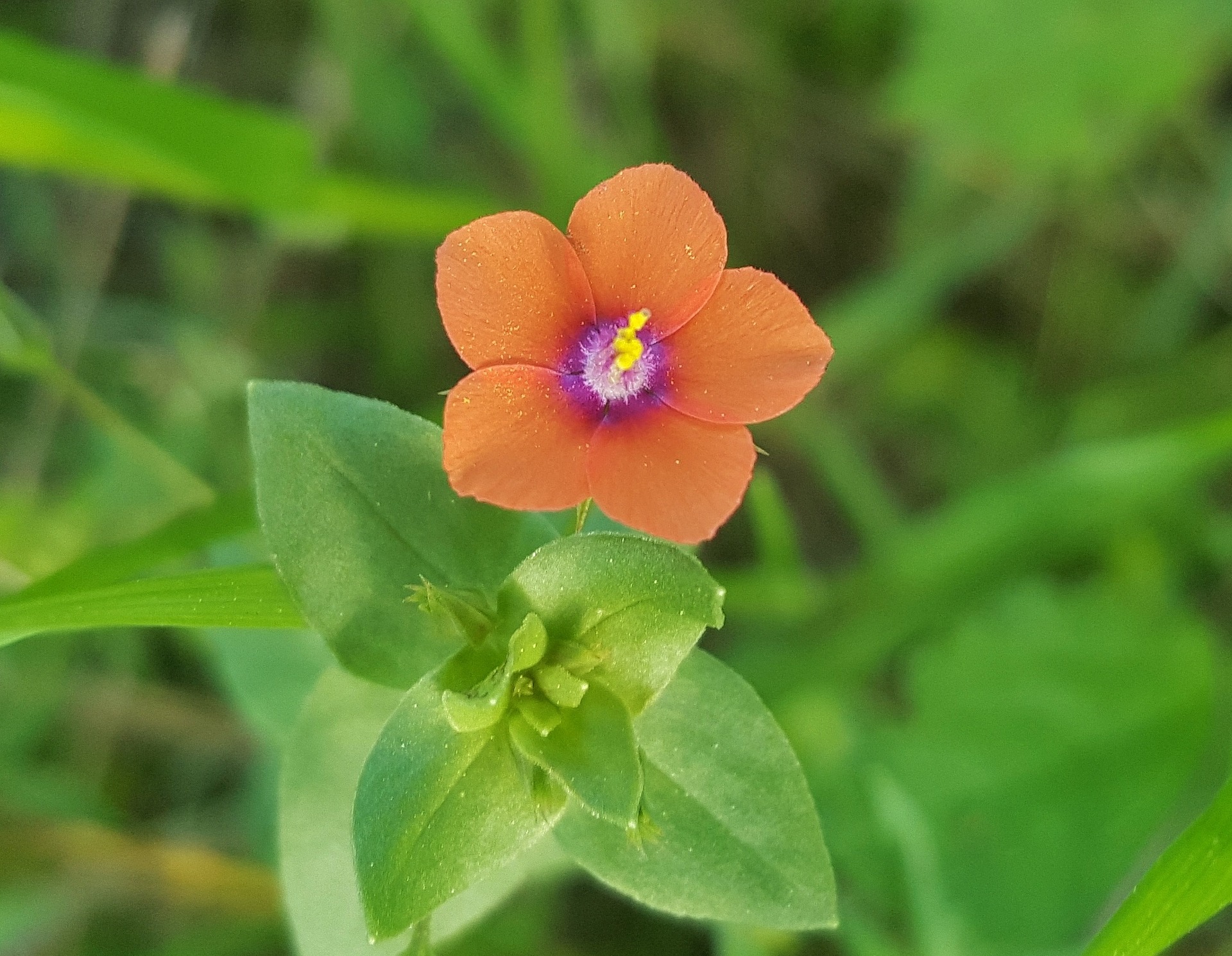
Key identifying features
Common chickweed can be confused with a flower-less Pimpernel. It has similar leaves but its stem is rounded with no hint of the square shape Pimpernel stalks have. If you’re still not sure, check to see if there are hairs under the leaves; Chickweed has completely smooth leaves.
Flowers:
- 5 rounded petals
- Salmon-orange colored
- Reddish-purple centers
- Closed during cloudy or cool weather (including at night)
Seeds:
- Tiny
- 3-sided
- Egg-shaped
- Black to brown colored
- Covered in wart-like projections
General:
- Square stems
- Football-shaped leaves
- Stalkless leaves
- Leaves have hairy undersides
Here is how to identify Scarlet Pimpernel (Anagallis arvensis)
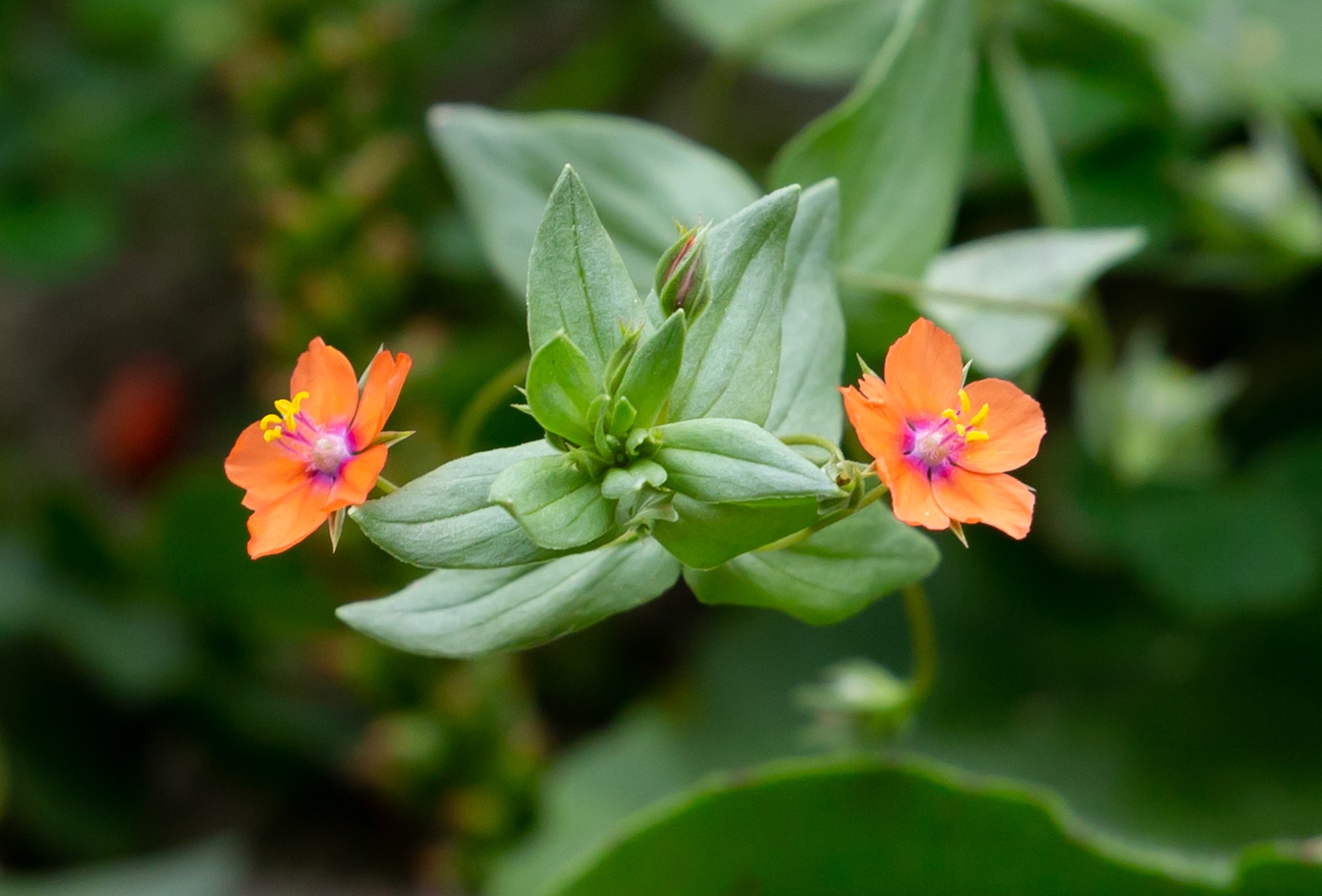
Trumpet Vine (Campsis radicans)
Cheerfully growing along the ground or up fences, light poles, and trees, Trumpet Vine is a big plant that makes itself known. The stems on this vine can reach up to 40ft in length and they have a tendency to envelope whatever structure they’re growing near. As an ornamental plant, they bring glossy dark leaves and showy flowers to their scenery.
While not edible, Trumpet Vines can be put to good use as erosion control. If you let them take over a piece of ground, their prolific roots can stabilize loose or pebbly soils. Pollinators like hummingbirds also love to come take a drink from the nectar hidden in the flowers. Be careful when planting it near structures as it is known to be highly flammable and difficult to restrain.
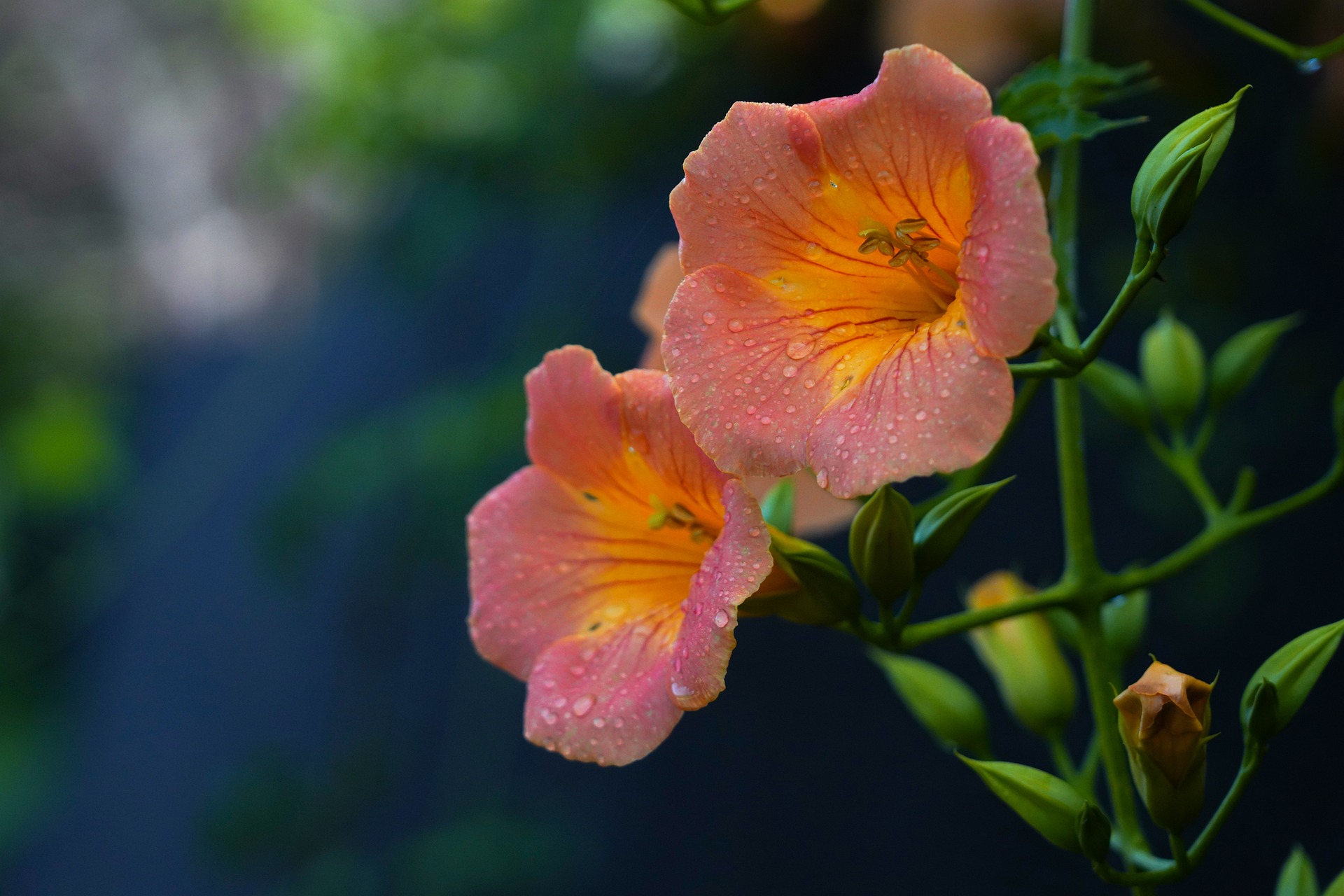
Key identifying features
Easily confused with Crossvine (see above).
Flowers:
- 3in long
- Red-orange
- Yellow-ish throats
- Tubular
- Clusters of 4-12
Seeds:
- Flat fruit capsules
- Fruit capsules are up to 7 inches long
- Seeds are flat and winged
General:
- Coarsely toothed leaves
- Long, climbing stems
- Stems have u-shaped bundle scars
- Mature stems have light tan, flaky bark
- Narrow, ovate leaves
Here is how to identify Trumpet Vine (Campsis radicans)
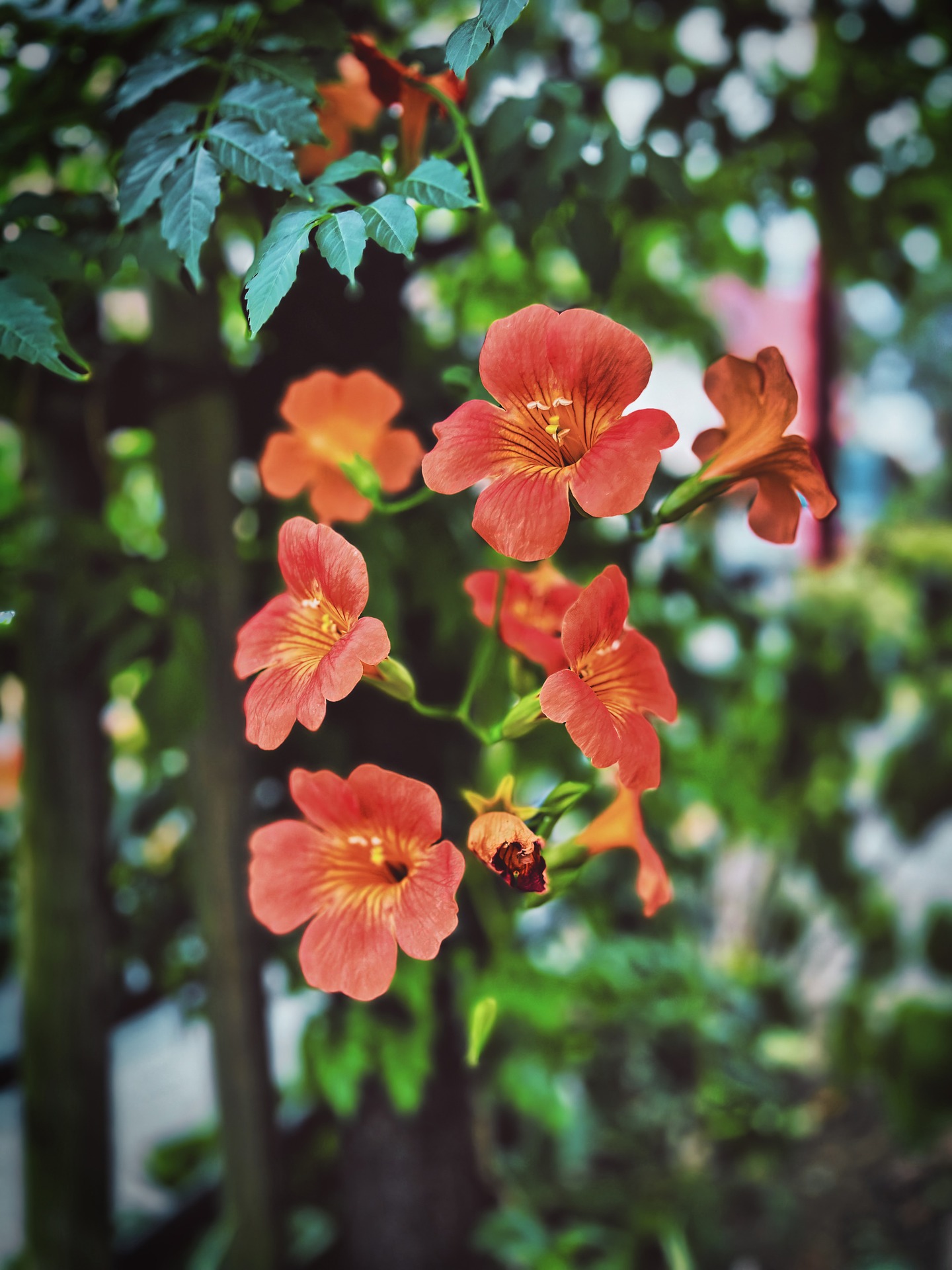
Wild Weeds
Looking for more information on wild weeds?
Edible Wild Weeds
Looking for other edible wild weeds?
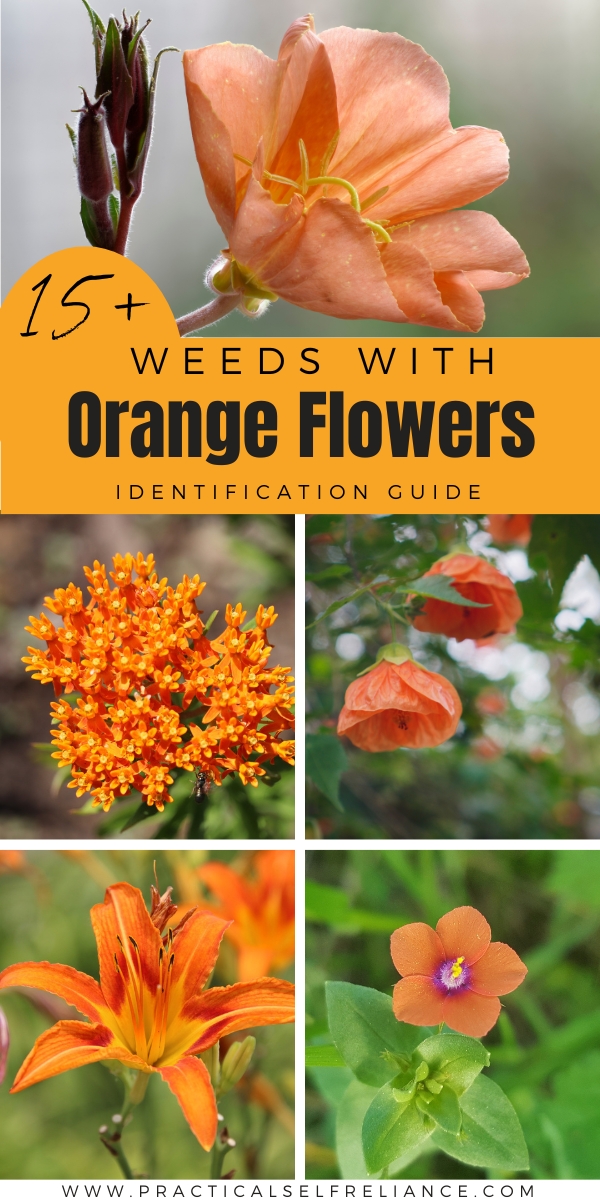

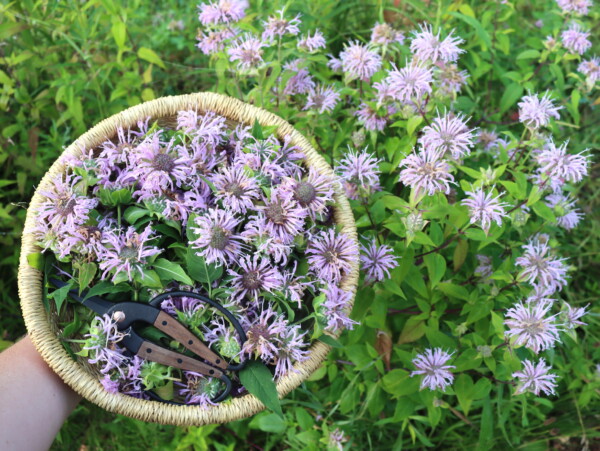
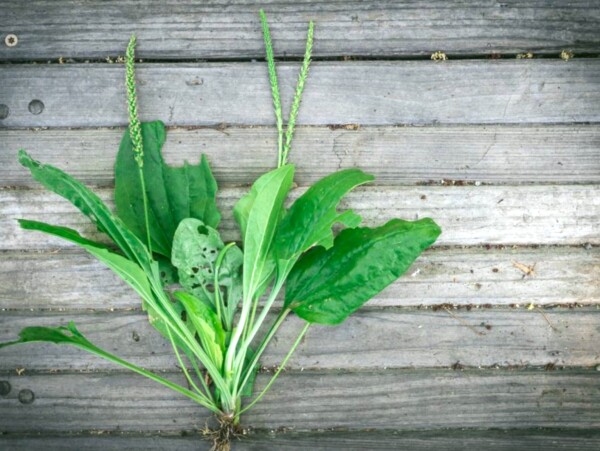
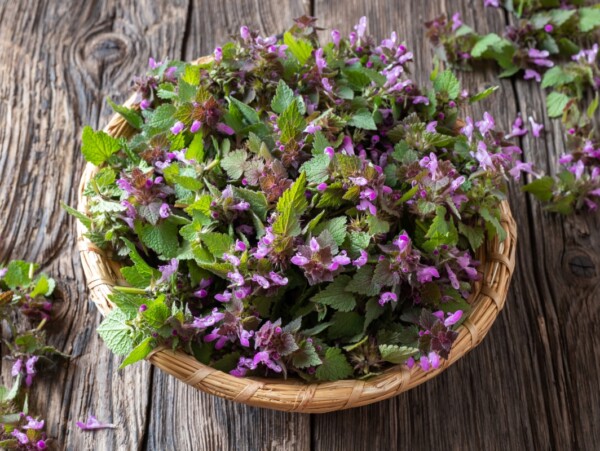
Wow!! I remember as a child I loved to collect flowers in a collection of colors, and now you will do it in the article! It’s so cool! I remember I had a lot of white and yellow ones, but orange or blue ones were very rare for me. But abshka was growing and I loved him very much. She also had purple ones, which also gave pollen. I loved collecting them so much and just even looking at them. Plants and flowers are beautiful creatures that deserve way more attention to themselves than they usually have. I think that sometimes we have to slow down and look more carefully at what surrounds us – at small details. on the characteristics of plants. Nature calms me down and I love her for it.